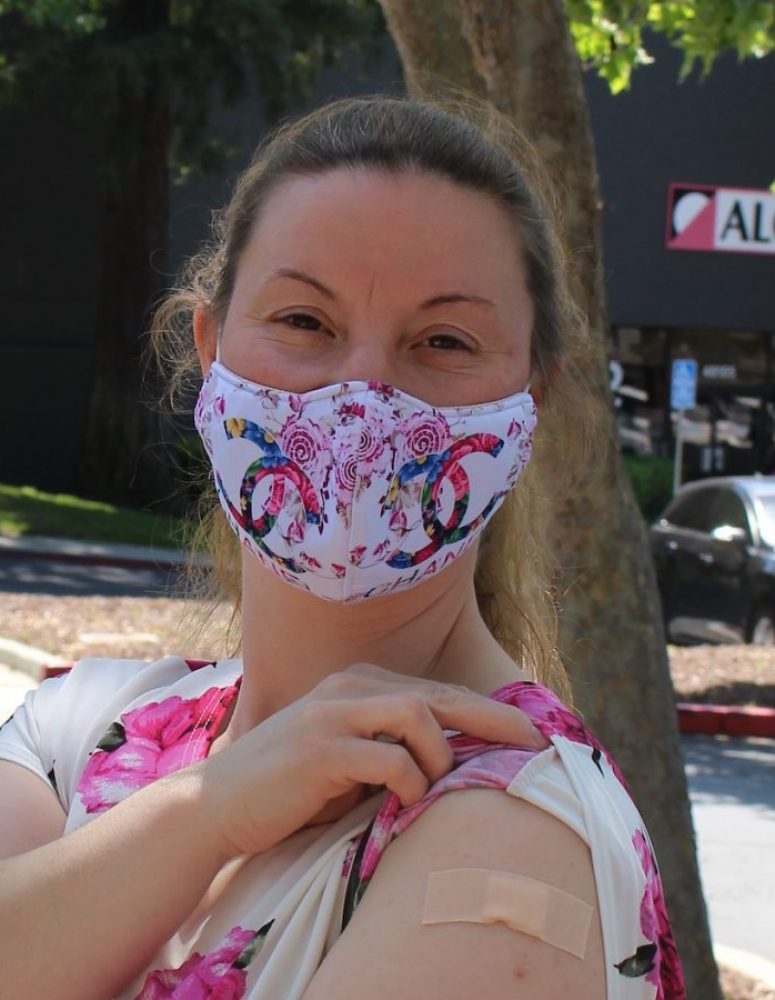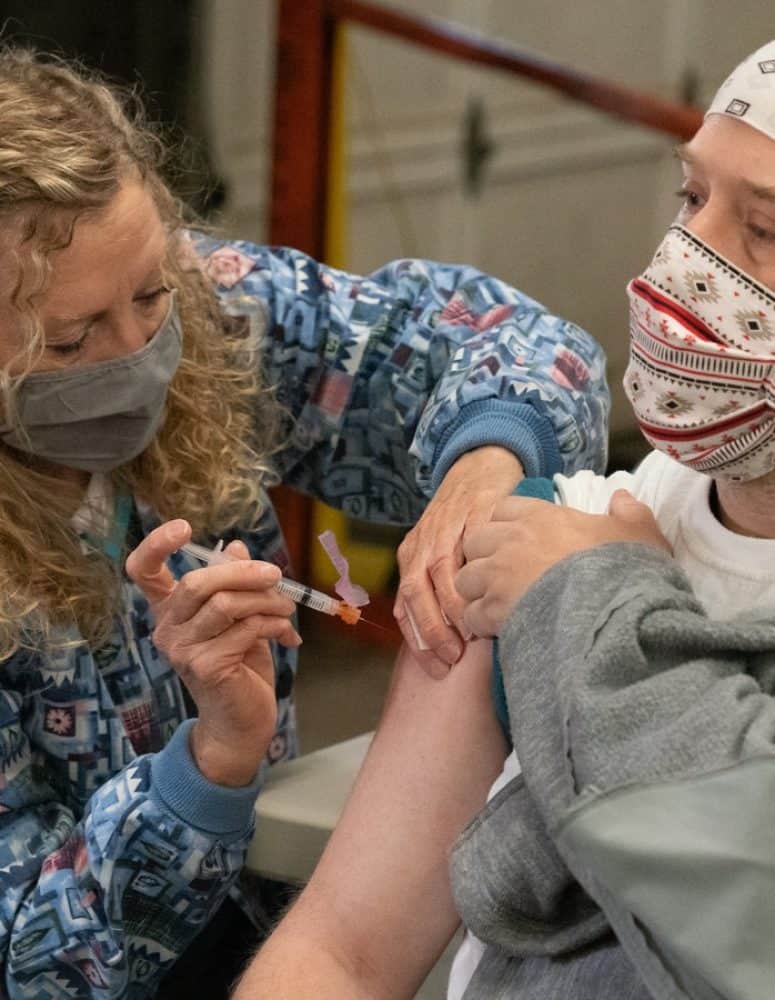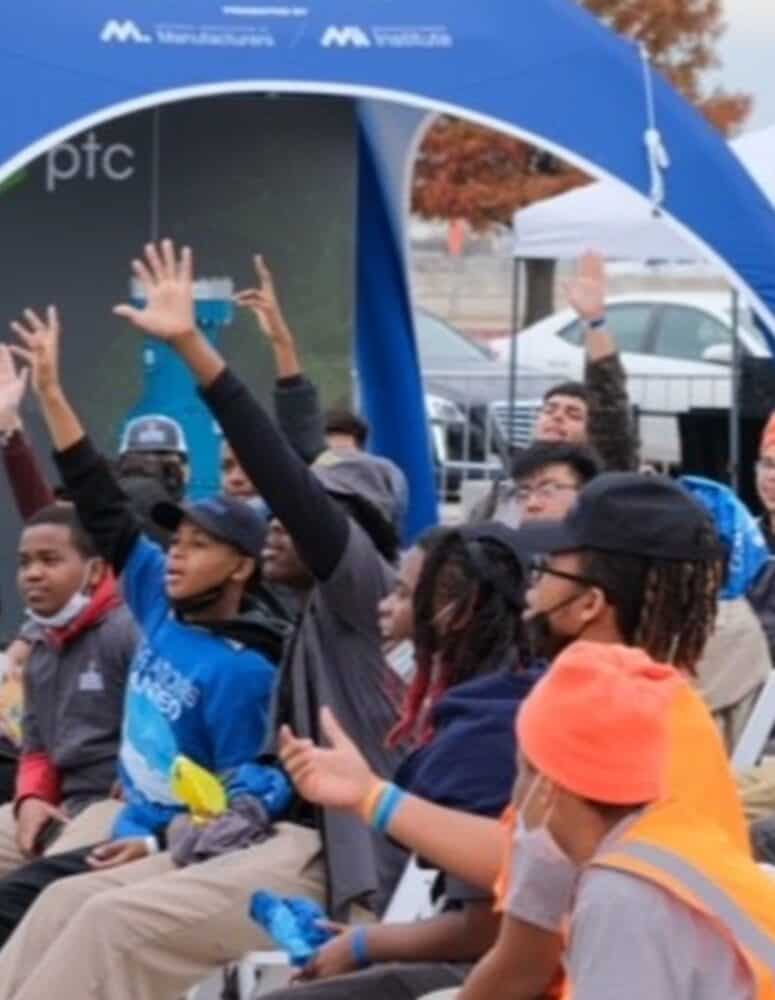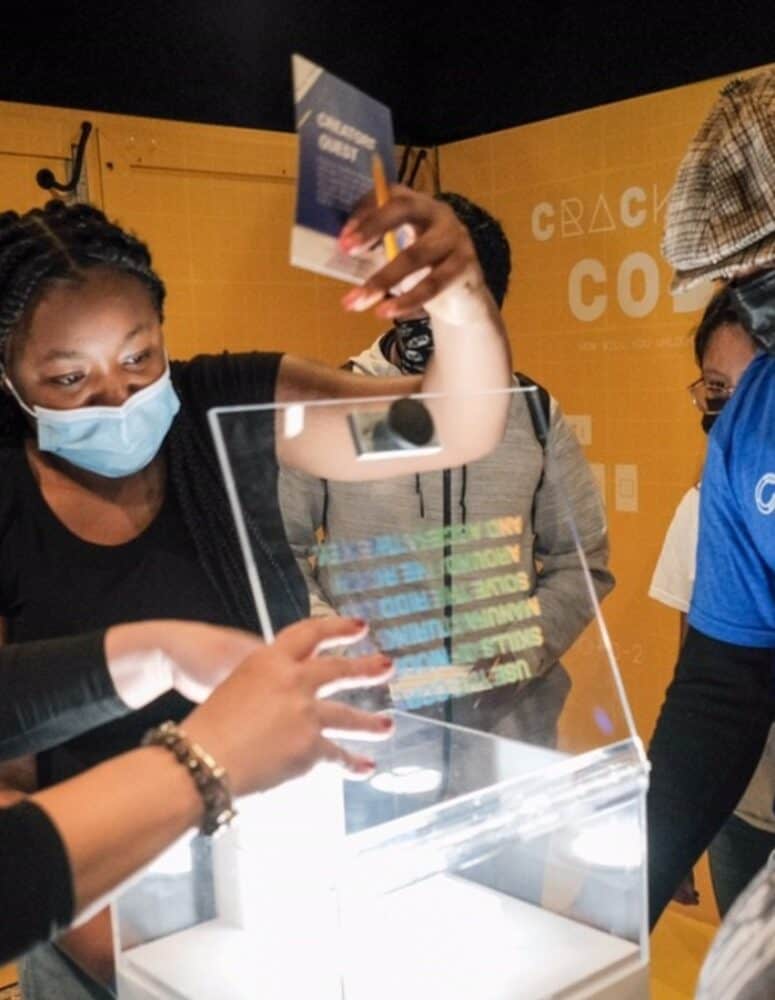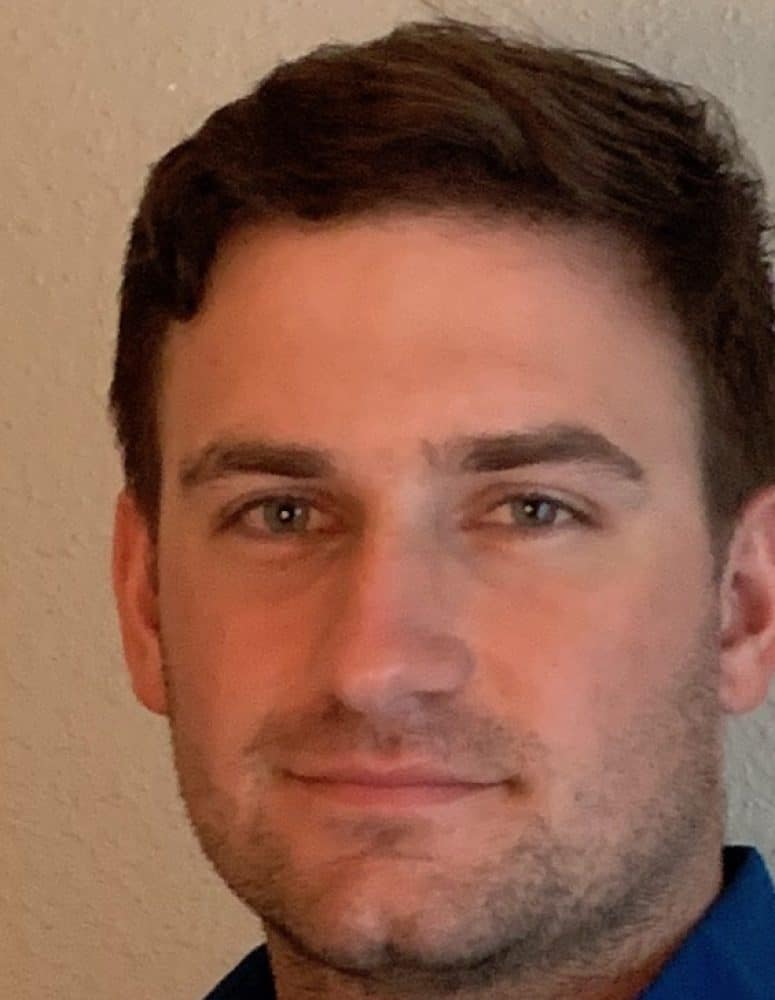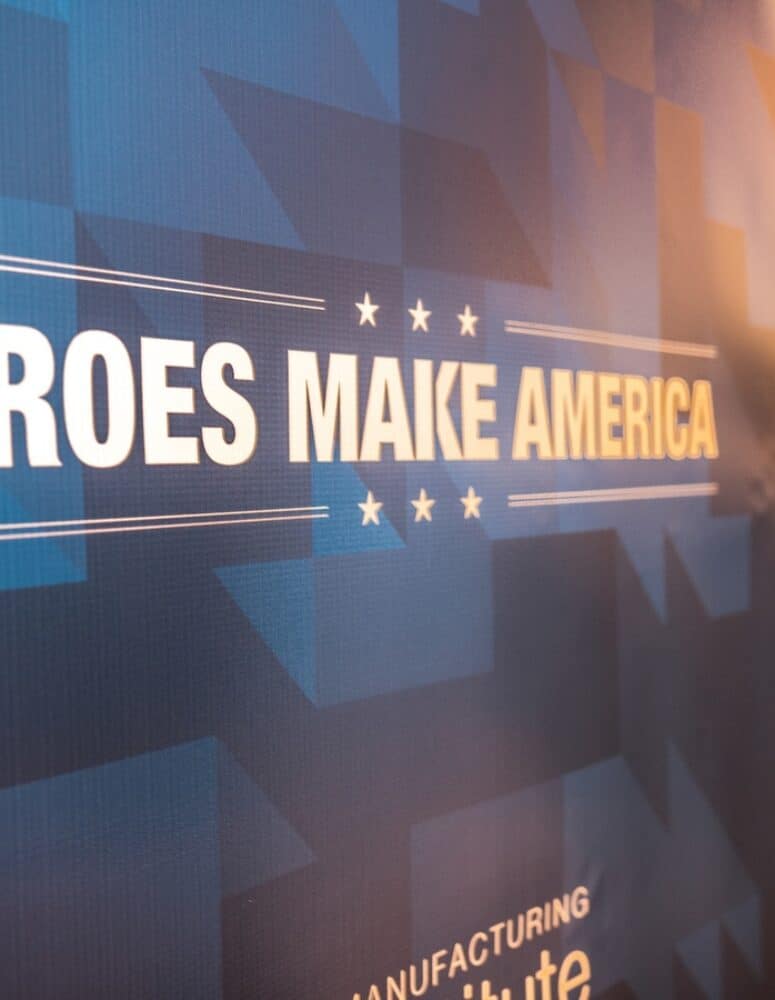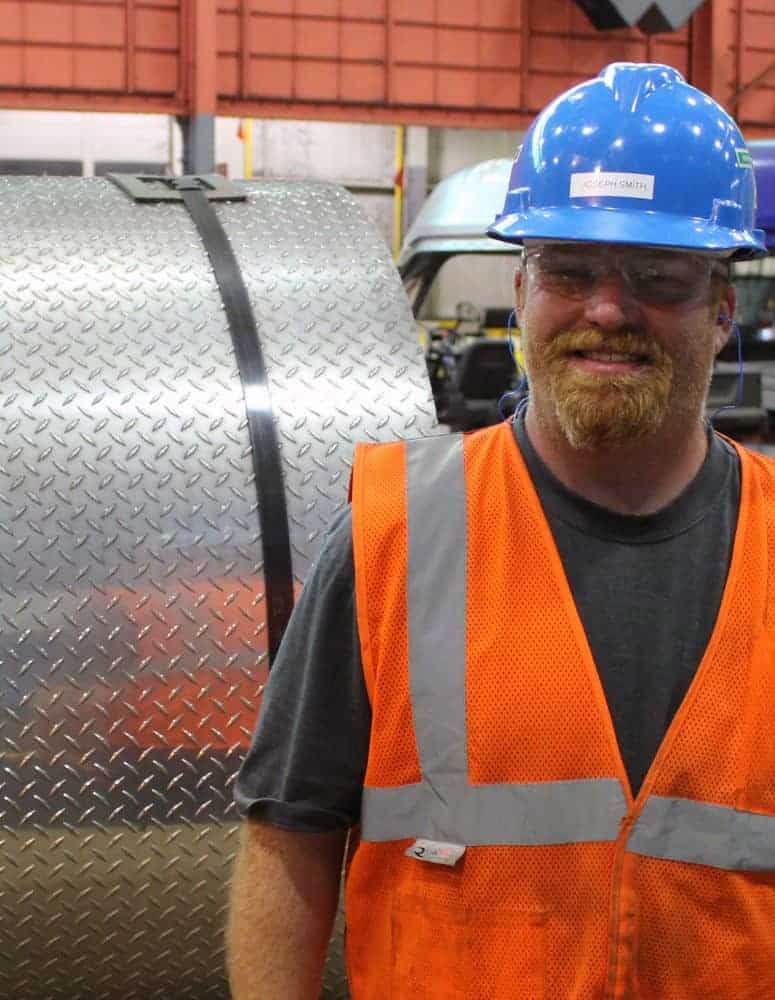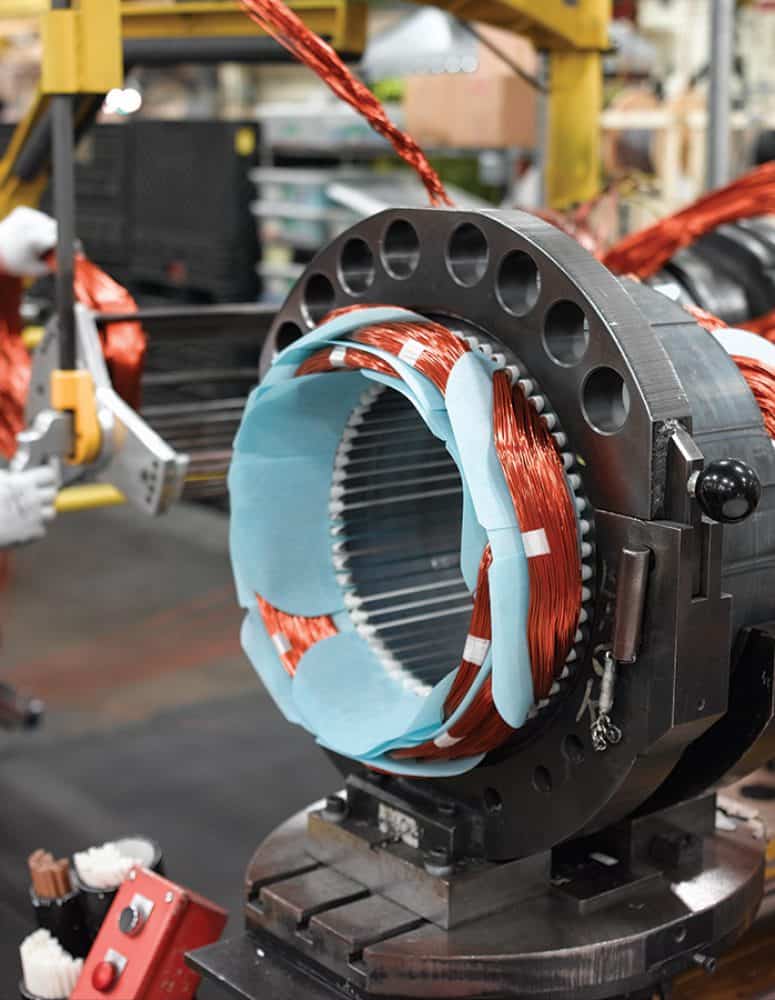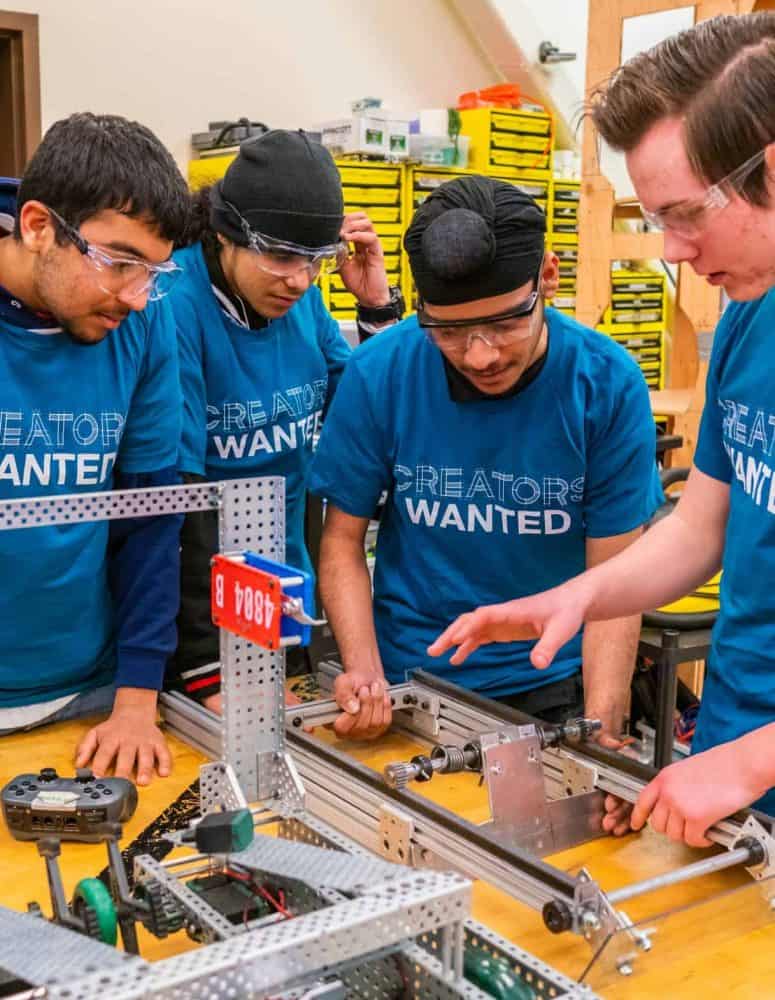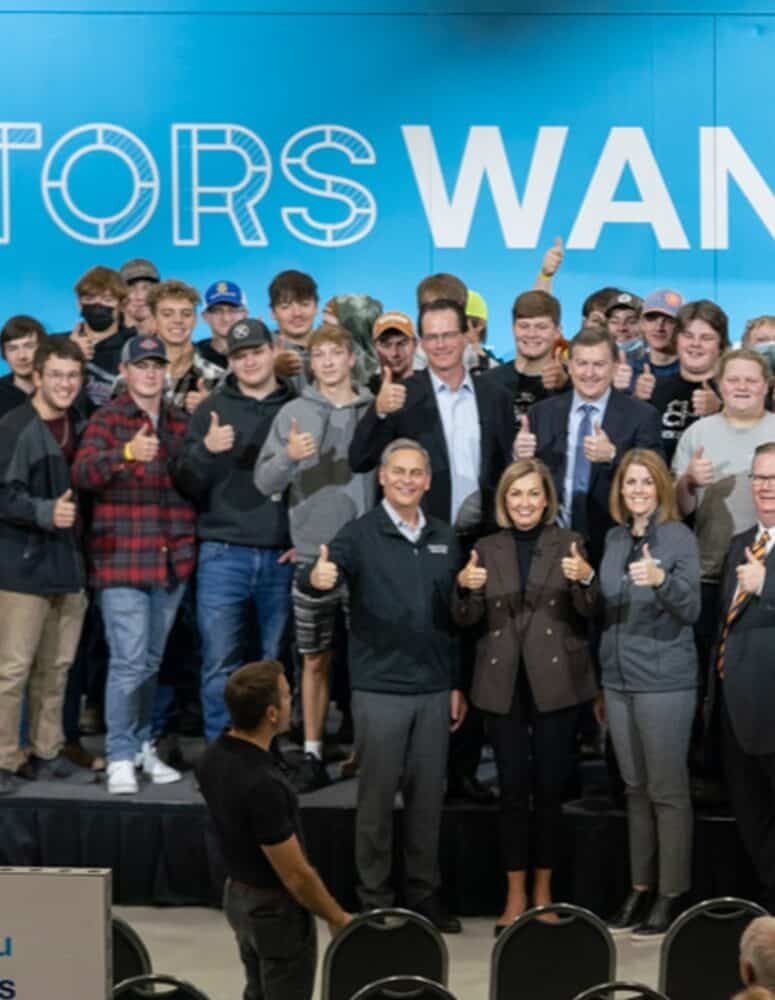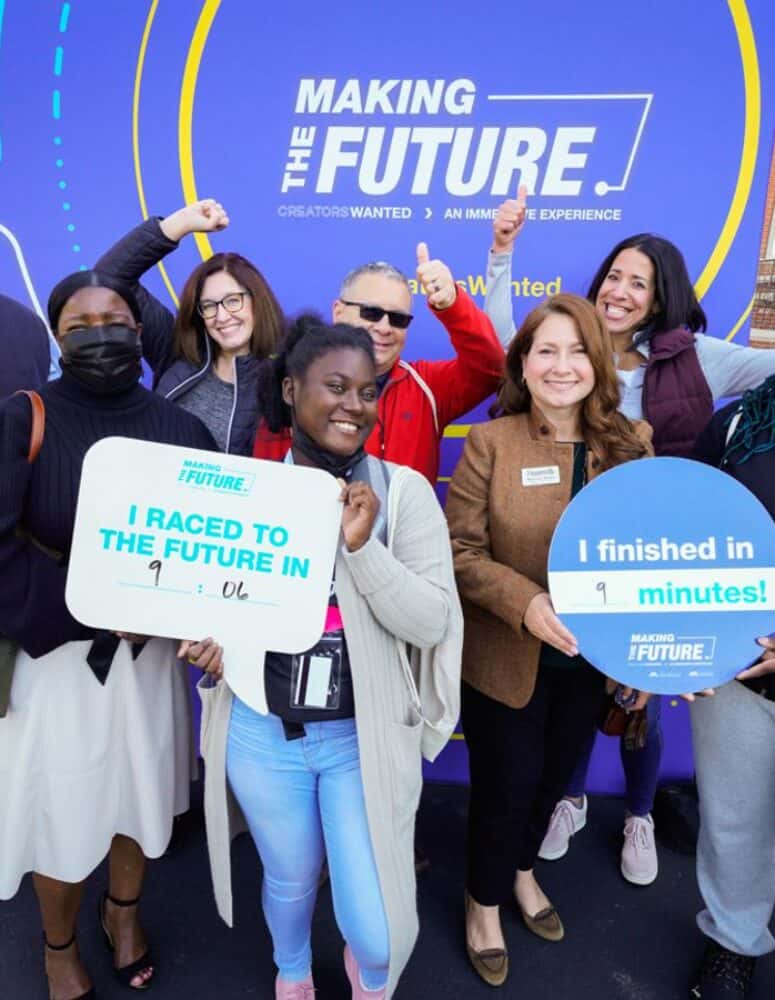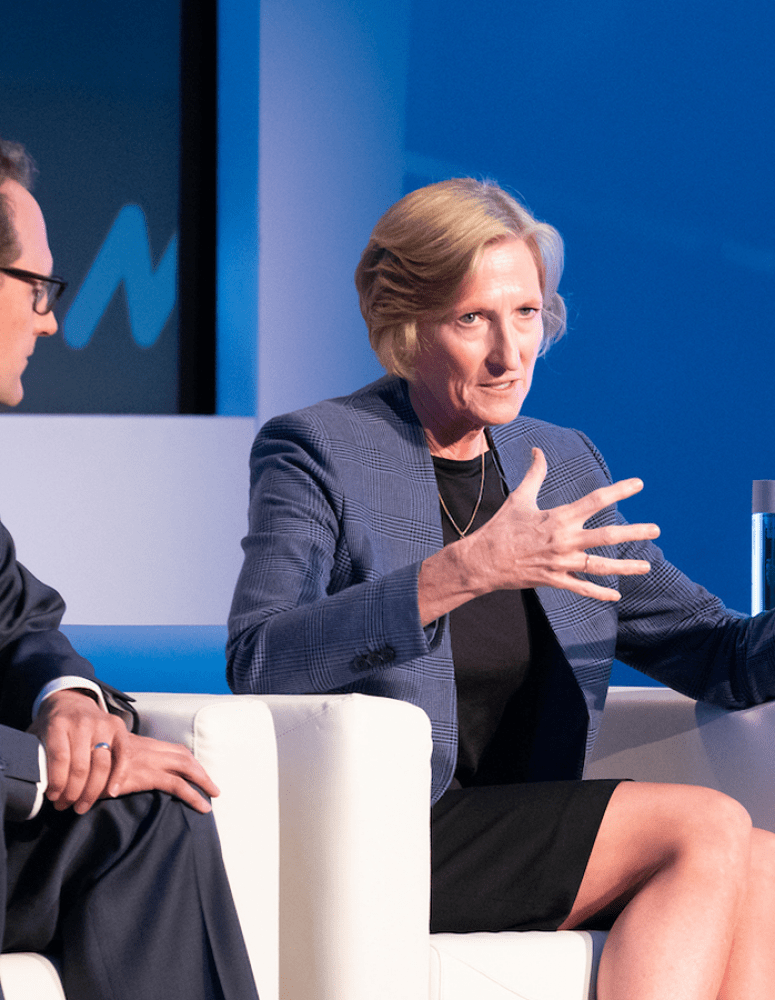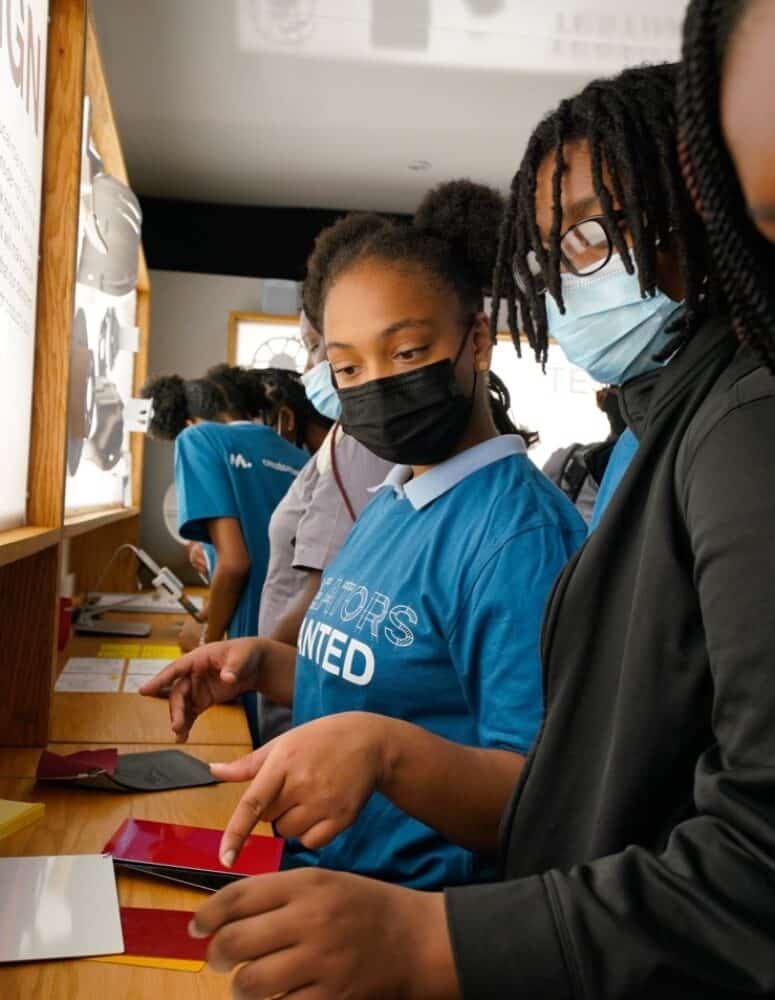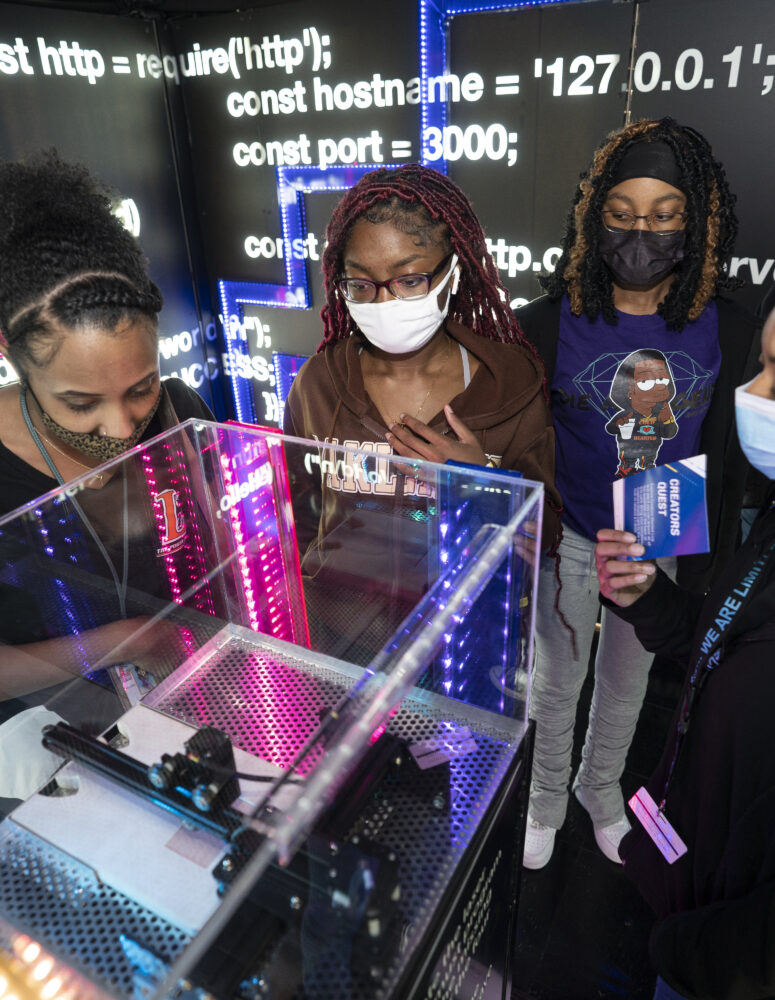Vaccine Myth Buster: Nephron’s Michaela Almgren Gets to Work
Get the Latest News
Get involved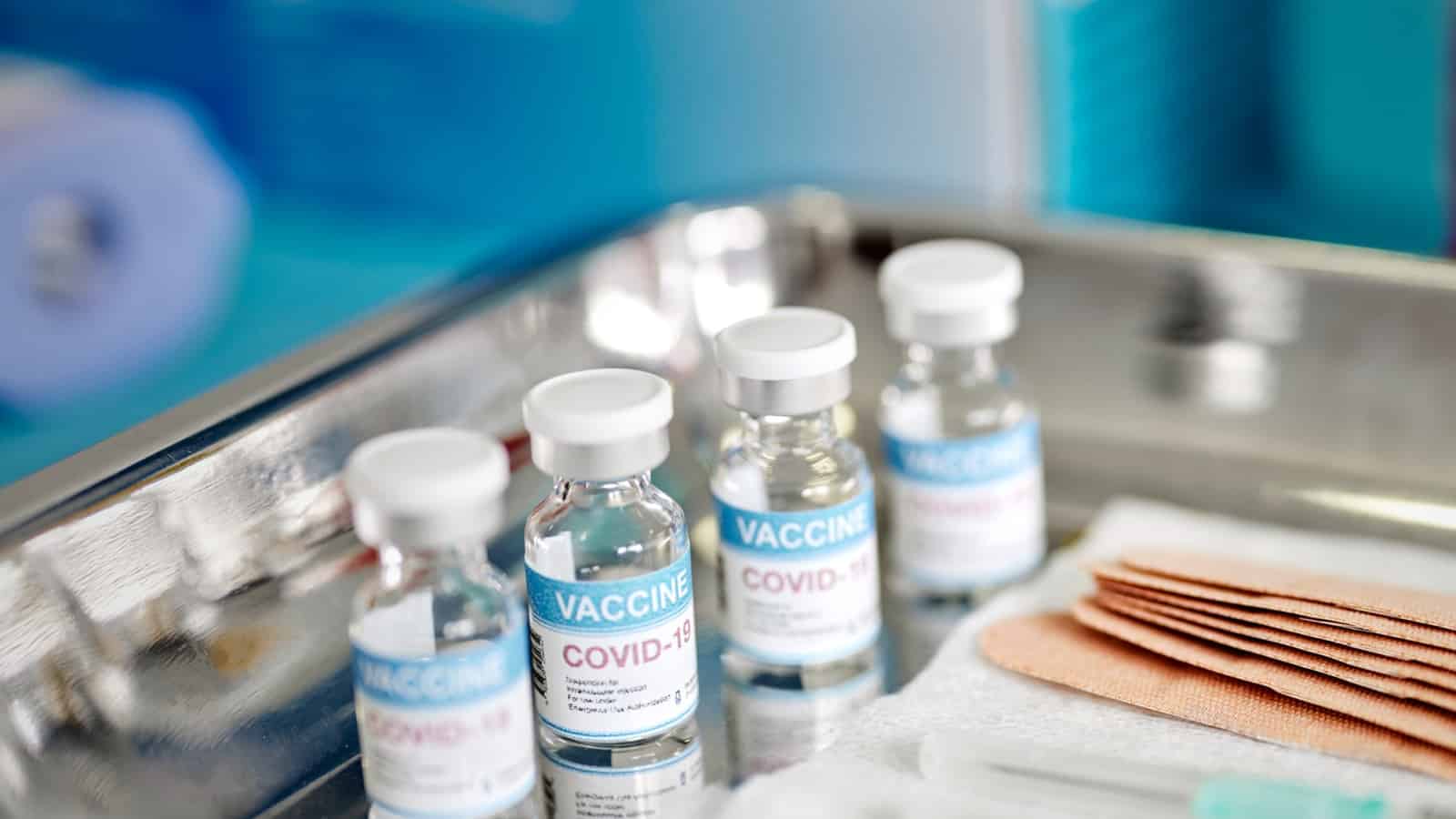
Michaela Almgren already has two jobs, but in recent months, she’s found herself appointed to a third: COVID-19-vaccine information hub.
A foot in each world: A pharmacist by training, Almgren divides her time between the University of South Carolina’s College of Pharmacy, where she is an assistant professor in the Department of Clinical Pharmacy and Outcomes Sciences, and Nephron Pharmaceuticals, where she is clinical adviser and pharmacy student internship director.
- Owing to her impressive background in drug formulation and analytical method development as a hospital pharmacist, as well as her skills as a lecturer, Almgren has also become a sort of de facto conspiracy-theory debunker when it comes to COVID-19 vaccination.
A go-to for facts: In recent months, in her capacity as both a professor and a Nephron employee, Almgren has given lectures and presentations about COVID-19, its variants and the vaccines—and she’s had significant follow-up questions from audience members. So many, in fact, that colleagues and others she has met teaching and at manufacturing gatherings have come to see her as a voice of reason capable of cutting through the noise.
- “A lot of people just fall into this misinformation mill” about the vaccine, Almgren said. “Typing in something like ‘Dangerous COVID-19 vaccine’ will give you this feed of articles, but it doesn’t mean the vaccine is dangerous.… That’s just how these [search engines] work.”
Convincing and calm: Almgren has been the impetus for the vaccination of several employees at Nephron, which has a 100% vaccination rate.
- “They’d say, ‘Thank you for talking with me. I was unsure about the vaccine, and it made me nervous, but talking with you made me feel that it was OK.’”
Fact vs. fiction: Almgren shared some of the top vaccine-related myths she’s successfully debunked during presentations and other conversations.
- “They have long-term side effects.” Fact: “This is where I talk about how these [vaccine] components don’t stay in your body more than 72 hours. The idea is just to elicit an immune response, and then it’s gone. And think about it on a global scale. If it was so deadly and terrible, by now we would see millions of people dropping dead or getting really sick” as a direct result.
- “They were rushed to market.” Fact: “When you actually look at how the clinical trial was defined, it was very similar to any other clinical trials for other vaccines. No shortcuts were taken. They just compressed the studies and ran them simultaneously.”
- “They’re not safe for kids.” Fact: “As a parent, I can totally understand why people would be concerned” about the vaccine for children, Almgren said. “But the clinical trial is out there, released and published in terms of how Pfizer did it. The data is clear showing the efficacy is there, and the side effects are minimal. If you have no issue with the polio vaccine or the tetanus shot, why is COVID-19 any different?”
- “Natural immunity is better.” Fact: “Natural immunity can be further boosted with the vaccine, and it wanes more than vaccine-induced immunity,” Almgren said. People who have had COVID-19 and get vaccinated “have an even stronger [immune] response.”
The last word: Check out the NAM and The Manufacturing Institute’s This Is Our Shot initiative to find out how you can protect yourself and the people you care about from COVID-19.
Sharpening America’s Competitive Edge
Get the Latest News
Get involved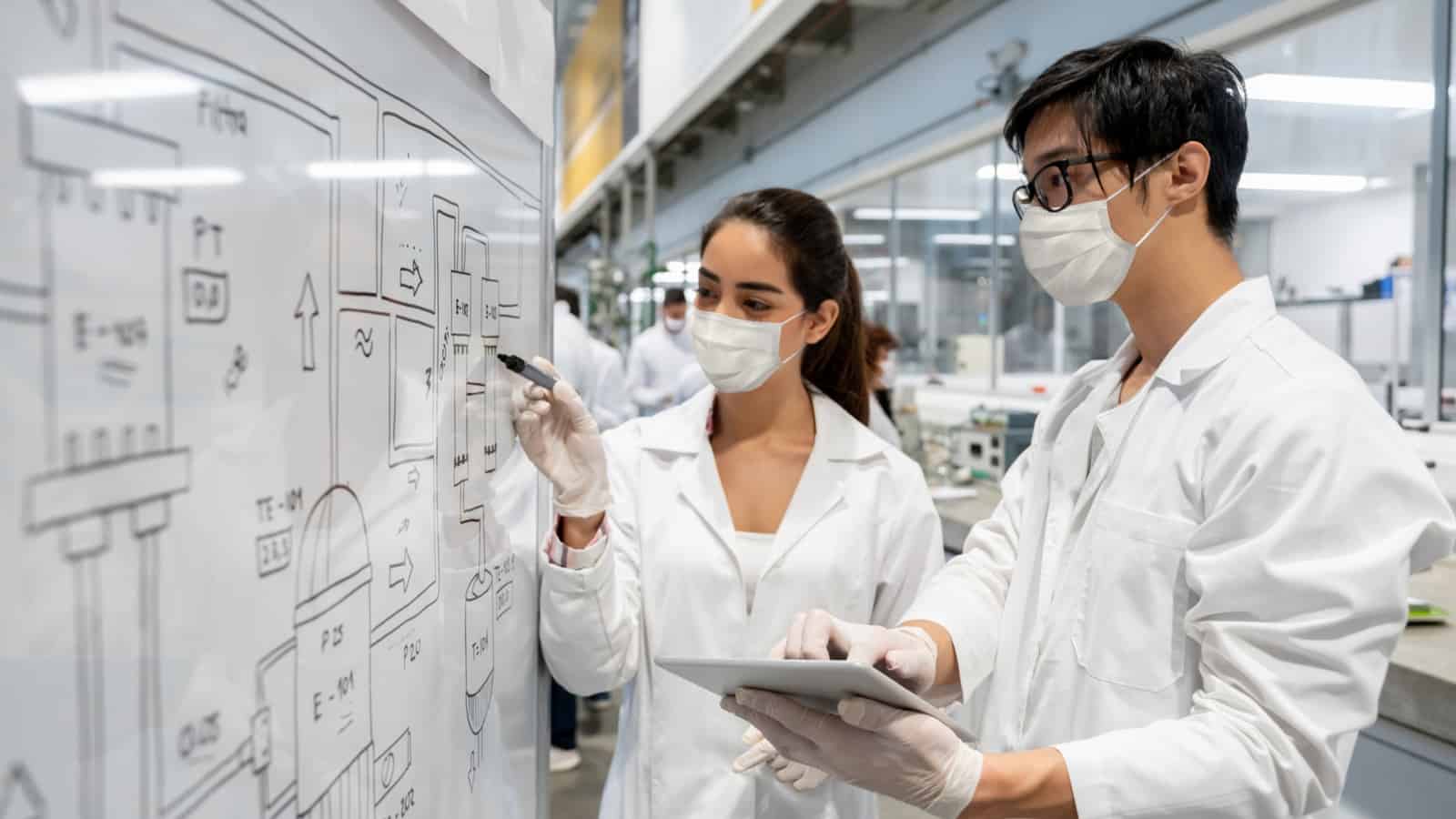
The Biden administration is making new commitments to semiconductor production and planning new policies designed to bring STEM talent to the United States—and manufacturing leaders are weighing in.
The background: Last week, the White House announced a series of actions to attract STEM talent, to strengthen the U.S. economy and to improve American competitiveness around the world.
What we’re saying: NAM President and CEO Jay Timmons joined Manufacturing Institute President Carolyn Lee in praising the actions, while also pushing for continued work on these critical issues.
- “The supply chain and economic disruptions facing American families and the manufacturing industry are driven in part by the severe worker shortage and by the serious chip shortage,” said Timmons. “Today, the White House has announced promising developments on both fronts, and we will work with the administration and Congress to build on this progress even further.”
- “Manufacturers are leading America’s recovery, but we still need to hire more than 800,000 workers right now,” said Lee. “And according to the MI’s research with Deloitte, we will have 4 million jobs to fill by the end of the decade, 2.1 million of which could go unfilled if current trends continue. That sustained need is why the NAM and the MI launched our nationwide Creators Wanted workforce campaign. It’s why we have long focused on programs and policies of all types that will grow the pool of STEM talent in America. We have to come at this crisis from every angle, and the MI and the entire industry will continue using every tool at our disposal to inspire, educate and empower the next generation of creators.”
The road ahead: Timmons highlighted the path forward and noted additional important actions to meet current and future needs.
- On semiconductor production: “To ramp up domestic semiconductor production, we can’t stop at today’s action, though,” said Timmons. “Too many manufacturing sectors have been unable to deliver the products American families need because they lack key components. Manufacturers are working overtime to overcome this challenge, but Congress has to do its part, which means passing USICA. Doing so will not only shore up our recovery and ease supply chain strains but also strengthen our economy and national security.”
On attracting STEM talent: “These immigration policies will also undoubtedly sharpen America’s competitive edge and help us outpace and out-innovate the rest of the world,” said Timmons. “In far too many cases, we’ve seen brilliant minds educated at American universities leave because our outdated immigration system doesn’t let them put their talents to work for America’s future. Now we can start to reverse that trend, among other key policy changes. As part of ‘A Way Forward,’ our plan for comprehensive immigration reform, we have long called for immigration policies that are responsive to clear economic needs. These policies meet that test, meaning that they will benefit our workers, our communities and our industry, empowering us to create even more opportunities for the American people.”
Labor Shortage Will Continue, But Manufacturing Is a Bright Spot
Shortage to Go On, But Manufacturing a Bright Spot
Get involved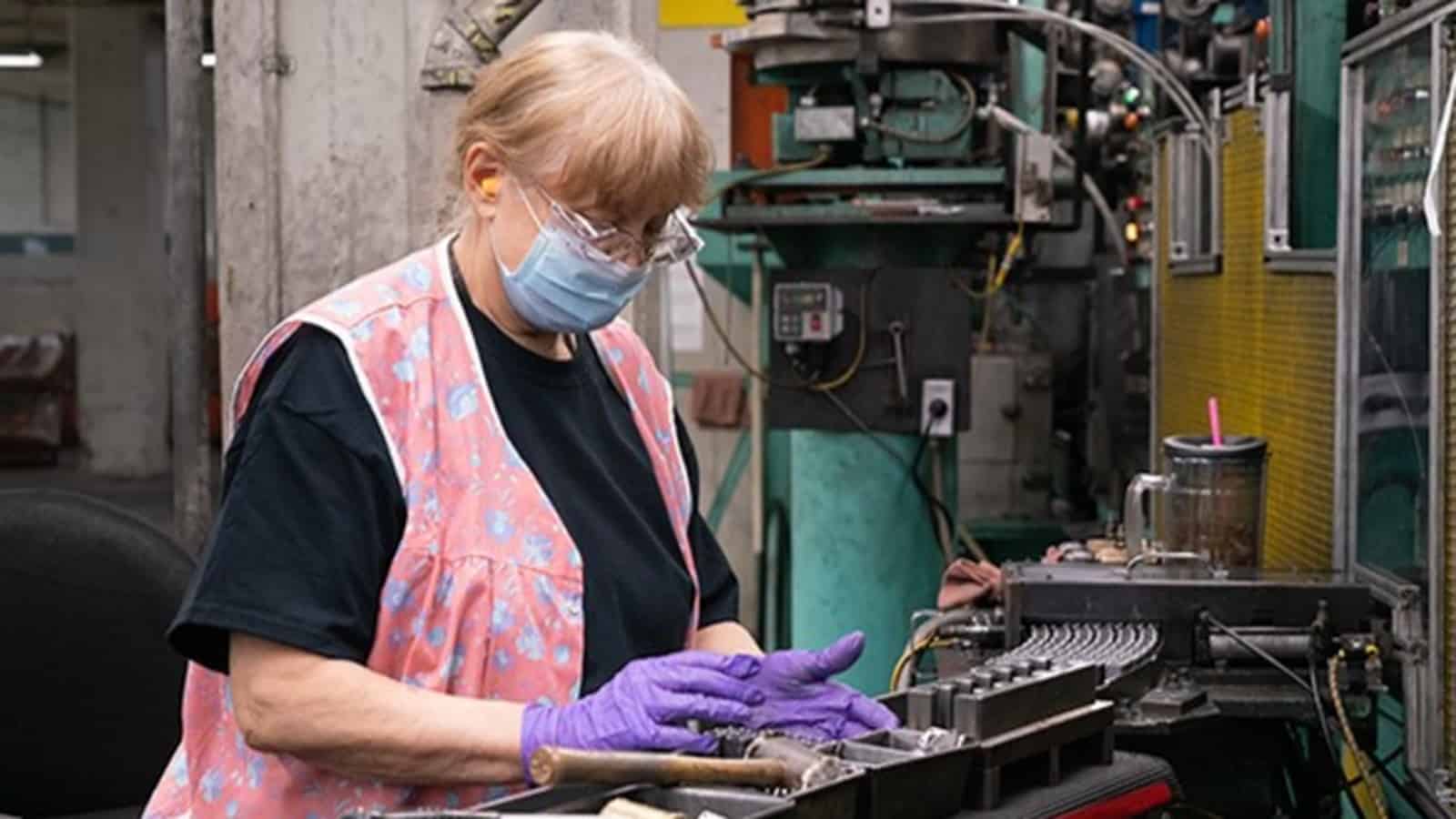
The future workforce will continue to ‘favor’ workers over employers, with the labor pool set to grow just 0.2% a year from 2024 to 2031, according to the Congressional Budget Office and Axios.
What’s happening: “In the 2010s, the massive millennial generation was entering the workforce, the massive baby boom generation was still hard at work, and there was a multi-year hangover from the deep recession caused by the global financial crisis. But now, boomers are retiring, millennials are approaching middle age, and the Gen Z that follows them is comparatively small.”
- Unlike in the recent past, organizations now and in the future won’t be able to count on “a flood” of job applicants for all advertised positions.
What it means for manufacturers: “On the one hand, manufacturers added 349,000 manufacturing workers in 2021, the most since 1994, and on the other, the sector has 219,000 fewer workers today than it did before the pandemic began,” said NAM Chief Economist Chad Moutray.
- “In addition, job openings remain near record highs, and firms continue to note difficulties in finding and retaining workers. In 2022, we would expect to add around 150,000 to 180,000 employees, building on last year’s strong gains.”
What it also means: “The reality of the labor shortage makes clear that we need an all-of-the-above solution to our workforce crisis,” said Manufacturing Institute President Carolyn Lee. “We need to attract new workers and provide them with the needed skills. That’s why the NAM and the MI’s Creators Wanted campaign is so critical and so timely. Research shows the next generation is looking for careers that matter. They want to have an impact, and they want the potential for family-supporting jobs with upward mobility, all of which are characteristics of modern manufacturing.”
“This data also underscores why we also need comprehensive immigration reform to ensure that we are bringing the best and brightest to the U.S. to help strengthen manufacturing in America.”
Manufacturing Leaders Welcome White House STEM Policy Push
Washington, D.C. – National Association of Manufacturers President and CEO Jay Timmons and Manufacturing Institute President Carolyn Lee released the following statement on the administration’s announcements on semiconductor production and new policy efforts to attract STEM talent to the United States:
“The supply chain and economic disruptions facing American families and the manufacturing industry are driven in part by the severe worker shortage and by the serious chip shortage. Today, the White House has announced promising developments on both fronts, and we will work with the administration and Congress to build on this progress even further,” said Timmons. “To ramp up domestic semiconductor production, we can’t stop at today’s action, though. Too many manufacturing sectors have been unable to deliver the products American families need because they lack key components. Manufacturers are working overtime to overcome this challenge, but Congress has to do its part, which means passing USICA. Doing so will not only shore up our recovery and ease supply chain strains but also strengthen our economy and national security.
“These immigration policies will also undoubtedly sharpen America’s competitive edge and help us outpace and out-innovate the rest of the world. In far too many cases, we’ve seen brilliant minds educated at American universities leave because our outdated immigration system doesn’t let them put their talents to work for America’s future. Now we can start to reverse that trend, among other key policy changes. As part of ‘A Way Forward,’ our plan for comprehensive immigration reform, we have long called for immigration policies that are responsive to clear economic needs. These policies meet that test, meaning that they will benefit our workers, our communities and our industry, empowering us to create even more opportunities for the American people.”
“Manufacturers are leading America’s recovery, but we still need to hire more than 800,000 workers right now,” said Lee. “And according to the MI’s research with Deloitte, we will have 4 million jobs to fill by the end of the decade, 2.1 million of which could go unfilled if current trends continue. That sustained need is why the NAM and the MI launched our nationwide Creators Wanted workforce campaign. It’s why we have long focused on programs and policies of all types that will grow the pool of STEM talent in America. We have to come at this crisis from every angle, and the MI and the entire industry will continue using every tool at our disposal to inspire, educate and empower the next generation of creators.”
“All in all, it’s a day of positive developments for manufacturing in America,” added Timmons.
-NAM-
The National Association of Manufacturers is the largest manufacturing association in the United States, representing small and large manufacturers in every industrial sector and in all 50 states. Manufacturing employs more than 12.5 million men and women, contributes $2.52 trillion to the U.S. economy annually and has the largest economic multiplier of any major sector and accounts for 58% of private-sector research and development. The NAM is the powerful voice of the manufacturing community and the leading advocate for a policy agenda that helps manufacturers compete in the global economy and create jobs across the United States. For more information about the NAM or to follow us on Twitter and Facebook, please visit www.nam.org.
-The MI-
The MI grows and supports the manufacturing industry’s skilled workers for the advancement of modern manufacturing. The MI’s diverse initiatives support all workers in America, including women, veterans and students, through skills training programs, community building and the advancement of their career in manufacturing. As the workforce development and education partner of the NAM, the MI is a trusted adviser to manufacturers, equipping them with resources necessary to solve the industry’s toughest challenges. For more information on the MI, please visit www.themanufacturinginstitute.org.
Ducommun’s #MFGDay21 Was a Roaring Success
Get the Latest News
Get involved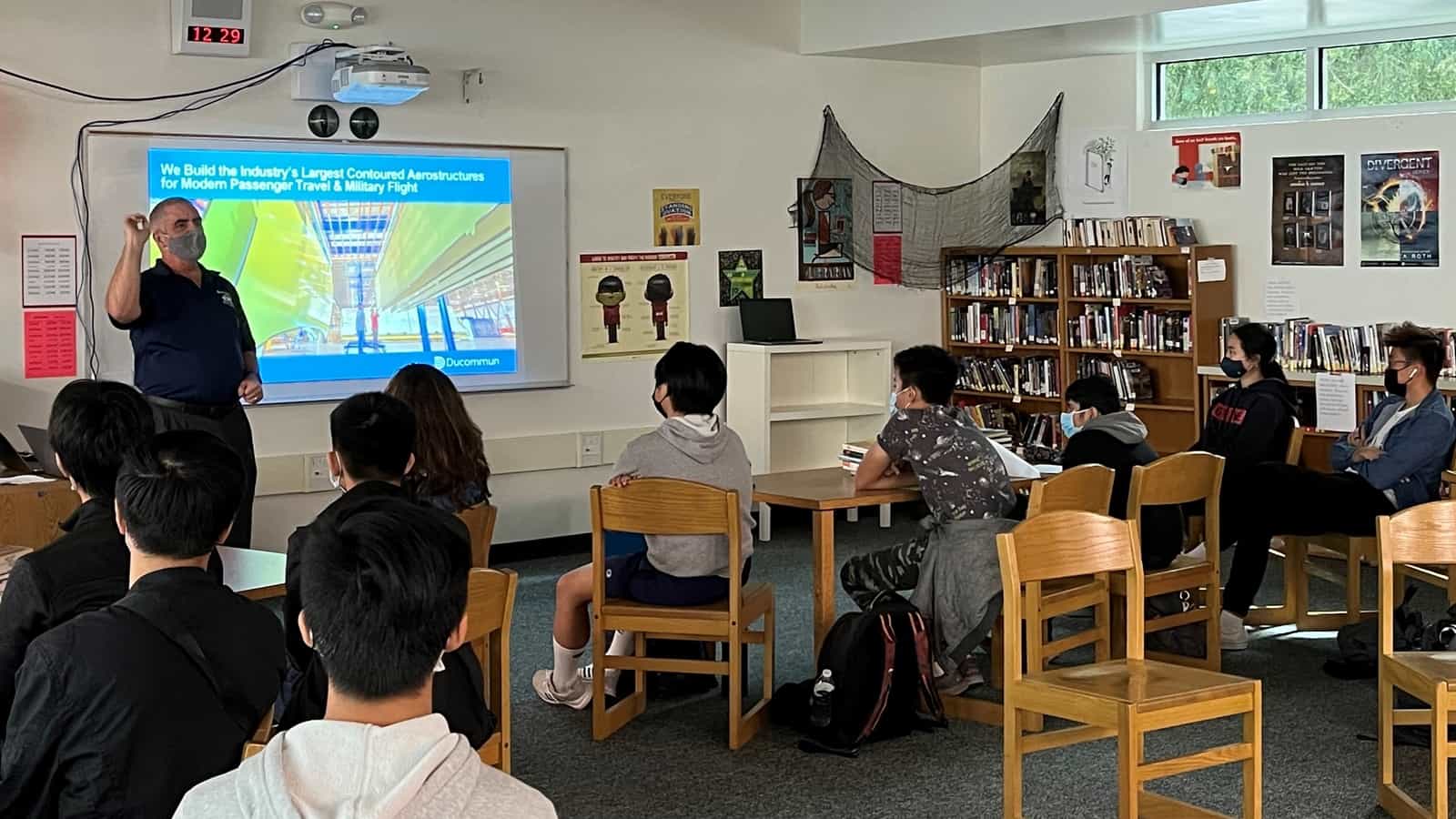
It would have been an impressive feat no matter what, but Ducommun’s achievement of a robust and highly attended MFG Day 2021 was made all the more remarkable by the fact the company had been an NAM member for just nine months.
MFG Day, an annual program of the NAM’s nonprofit workforce development and education partner, The Manufacturing Institute, highlights the opportunities and potential of modern manufacturing careers by encouraging thousands of companies and educational institutions around the nation to open their doors to students, parents, teachers and community leaders.
“As a leader in innovative manufacturing, Ducommun supports National Manufacturing Day, as well as other education and community-based STEM programs and initiatives, that nurture and develop the next generation of creators, builders, technicians and innovators,” said Chonta Salts, Ducommun corporate HR business partner. “Our goal for MFG Day was to engage with students, parents and educators to broaden their understanding of modern manufacturing and to highlight the range of full-time opportunities, internships and part-time summer jobs available to them.”
Their MFG Day: Ducommun, a 172-year-old Santa Ana, California-based provider of technology-driven structural and electronic solutions for the aerospace, defense and industrial markets, coordinated employee and representative visits with 11 high schools and colleges nationwide. Each school is local to one of Ducommun’s U.S. manufacturing performance centers.
- Events were held in person at Ducommun, in classrooms at local schools and online through livestream. Ducommun leadership teams, engineers, technicians and production team members engaged with students about what a career in modern manufacturing is really like—and how much room it offers for professional growth and advancement.
- “Employees shared their own success stories: starting out in entry-level production positions, completing training programs to advance to technical, engineering or other professional positions and what they do in their current role,” said Ducommun Vice President and Chief Human Resources Officer Rose Rogers. “I think that’s a key component of rolling it out. You have to engage with students at their level. By having our employees connect with the students, they were able to ask questions directly to our employees.”
What they did: Ducommun’s MFG Day success was bolstered by the fact that the company has long been involved in sponsoring local-school science, technology, engineering and math (STEM) activities. So come October, it already had many connections at nearby schools.
- Ducommun team members attended the virtual training sessions offered on the MFG Day section of creatorswanted.org,Salts said.
- Using the site’s resources page, Salts worked with the company’s communications team to transform their standardized presentation into one for high school audiences that could be easily customized by HR leaders responsible for local events.
- Rogers and Salts “got buy-in and feedback from senior leadership” early in the planning process.
- They ensured their events were dynamic, interactive and interesting to the students because “we didn’t want to sit them in a conference room, watch a presentation and wish they were back at school!” Rogers said, with a laugh.
Facts and figures: Ducommun started its MFG Day planning “months” in advance, Salts said, and the work paid off. Here are some of the specific results:
- More than 500 students attended and participated in Ducommun’s MFG Day events.
- There were five in-school presentations by Ducommun team members.
- The day included 17 student presentations.
- There were six onsite visits by students to Ducommun performance centers.
- The day had one virtual presentation.
The payoff: Ducommun’s participation in MFG Day is part of its commitment to build the next generation of creators and innovators, Salts said. Though it’s still too early for the company to have reaped the workforce rewards of its autumn outreach, Rogers said it has received a great deal of interest from students about full- and part-time jobs after graduation. Ducommun expects to fill many open positions in late spring and summer 2022.
- “We invested in MFG Day because one of our core beliefs and commitments is to support the communities where we live and work,” Rogers said. “We emphasized that working at Ducommun wasn’t going to be just a job—this could be a long-term play for students because they can build a career with us. Being able to engage with them was invaluable.”
For more information on MFG Day and how to host a successful one next year, visit www.creatorswanted.org/resources/.
A Helicopter Mechanic’s Manufacturing Career Takes Off
Get the Latest News
Get involved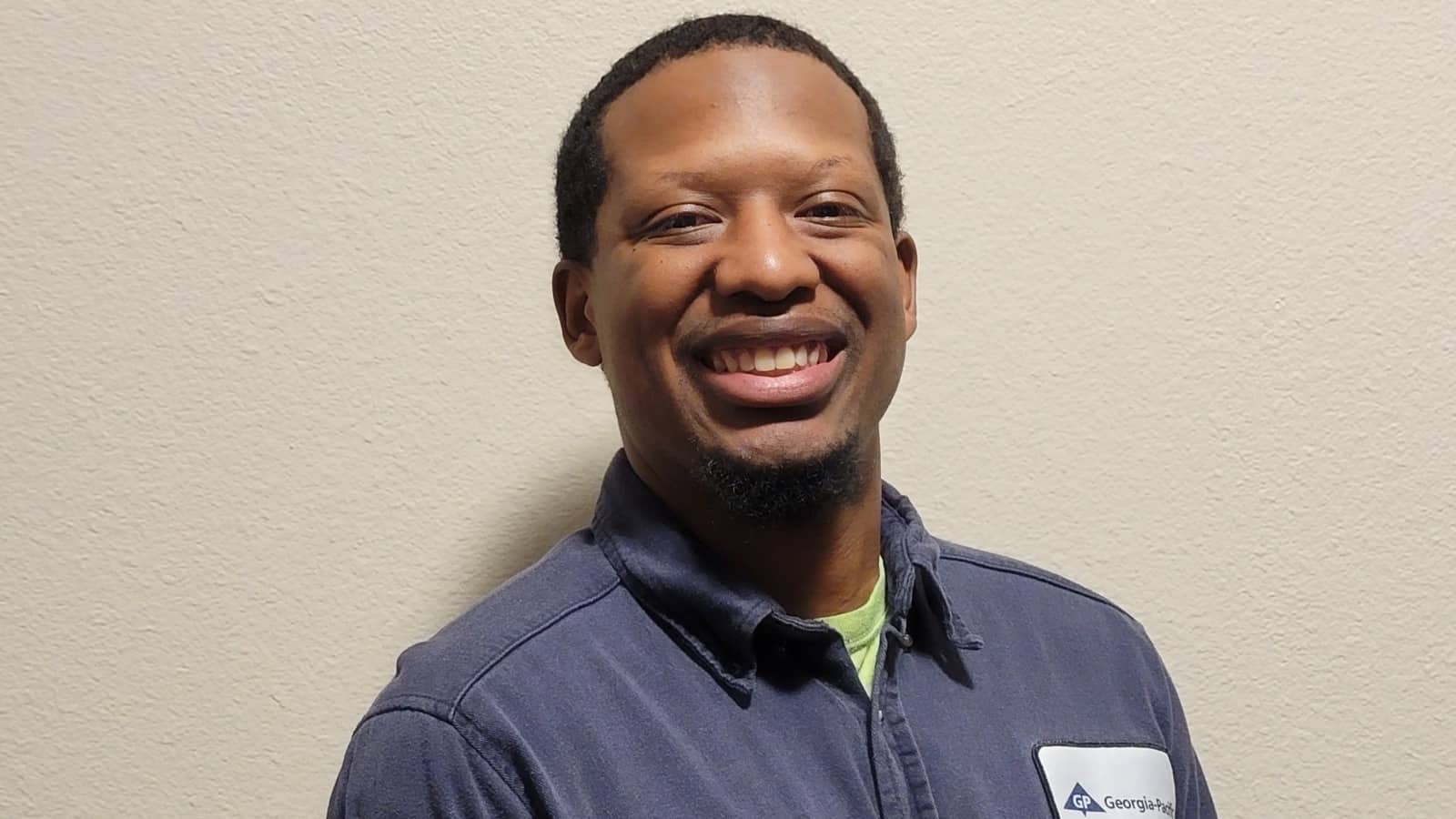
Marsalis Leonard didn’t grow up in a gearhead family, but from the beginning of his eight years as a helicopter mechanic in the U.S. Army, he was immersed in a world of skills he would never have anticipated seeking out on his own.
- “The Army was my introduction to mechanics,” said Leonard. “It taught me how different machines and processes work together, but it also taught me how to grasp hands-on knowledge and put it to use.”
A new career: That kind of experience served Leonard well when he transitioned out of the army in 2020. He had considered working in civilian aviation, but the process would have required additional education and a range of specific certificates. For Leonard, more school wasn’t a priority—and when he learned about the Manufacturing Institute’s Heroes MAKE America program at Fort Campbell, Kentucky, it seemed like a perfect opportunity to get started in a new field by putting his existing capabilities to use.
- “I wanted to jump into something with the skills I already had,” said Leonard. “Heroes MAKE America seemed like a great place to enhance my skills and turn them into a new career.”
An immersive program: The MI—the workforce development and education partner of the NAM—designed Heroes MAKE America as an integrated certification and career-readiness training program that helps prepare transitioning service members, veterans, National Guard members, reservists and military spouses for careers in manufacturing. The initiative offers in-person trainings and remote training options, as well as career support and placement. So far, the program has a 90% placement rate with graduates in 42 states across the country.
A learning opportunity: While Leonard brought plenty of his own experience to the table, Heroes MAKE America still offered valuable information and practical training in industrial maintenance that he continues to use today.
- “It was very enlightening,” said Leonard. “Heroes gave you an education in basic electronics, pneumatics, hydraulics and mechanics. It taught you to read schematics and diagrams, which was probably the first thing I was able to grasp. It was very hands-on.”
A new path: Through his experience in Heroes, Leonard was hired as a maintenance technician at a Waxahachie, Texas, facility owned by Georgia-Pacific—a pulp and paper manufacturer based in Atlanta, Georgia. While the role may be different from his experience in the military, the Heroes program prepared him to take on his new challenges.
- “I learned an insane amount,” said Leonard. “At first, it seemed overwhelming the amount I didn’t know. But I also was able to see people who have been in the industry for years—and they started out as kids with no experience. So, you work hard, pay attention, ask questions and learn from your mistakes. You’ll learn something—and you’ll use that knowledge.”
Get involved: Want to support Heroes MAKE America? Click here to learn more.
ABB Apprentices Join the Next Generation of Manufacturers
Get the Latest News
Get involved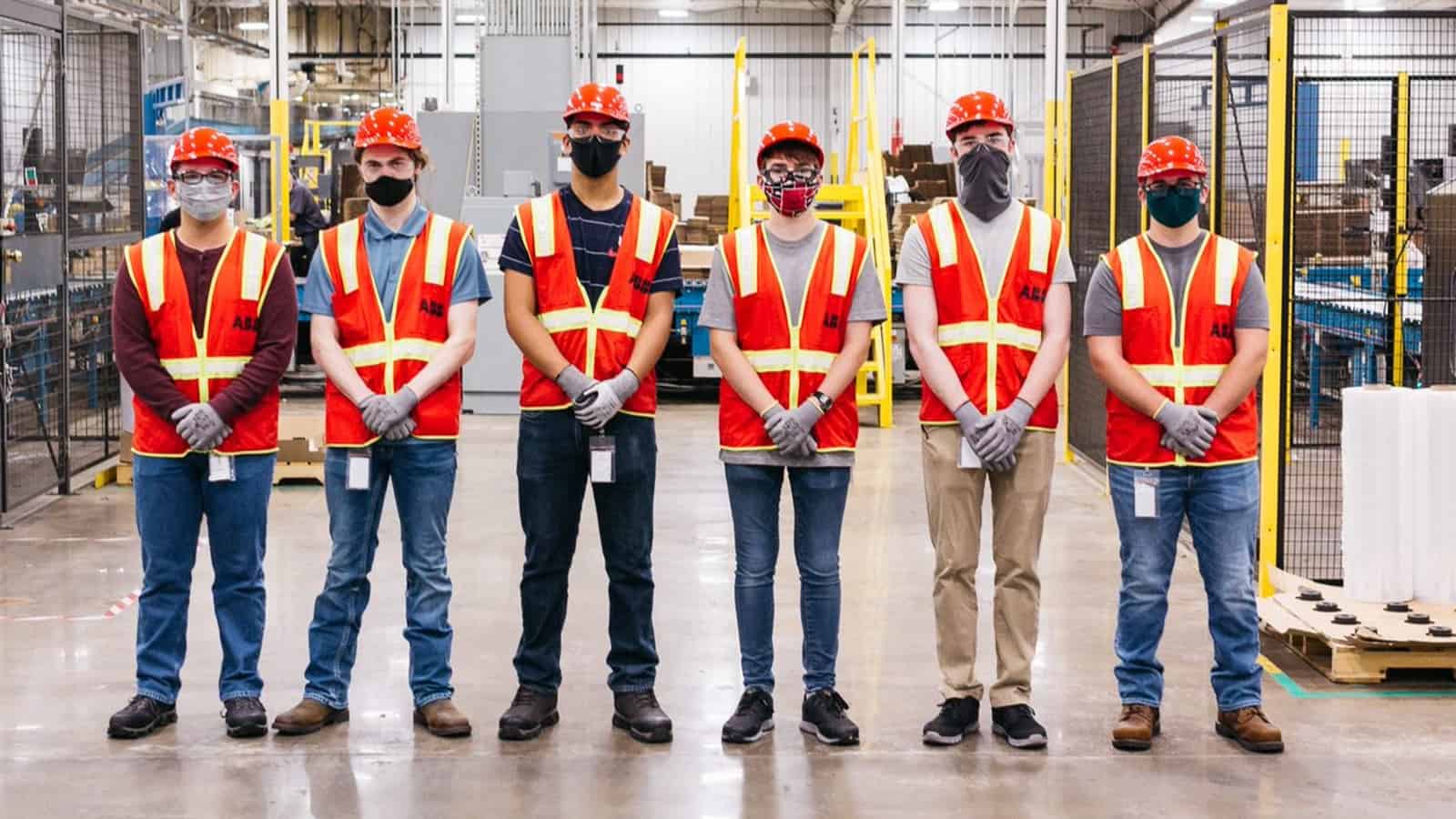
As manufacturers work to fill the skills gap and hire more employees, some are modernizing a tried-and-true approach: taking on apprentices. In Fort Smith, Arkansas, ABB—an industrial electric motor and robotics manufacturer—is leading the way with its innovative program for local high school students.
How it works: Apprentices work three hours per day, four days per week during the school year and then 40 hours per week during the summer. ABB trains them in a range of roles to provide them with a strong foundation in manufacturing skills and the ability to work their way into an advanced technician role.
A win-win: “These students are getting paid, and paid well for a part-time job,” said ABB Vice President of Operations Johnny McKusker. “They learn a variety of skills that most juniors and seniors in high school aren’t exposed to. And if they decide they like manufacturing and want to stay on, then we’re getting a person who joined us early, has had a lot of training and investment and is able to contribute at a high level early in their career.”
What comes next: Last year, nearly all of ABB’s apprentices took on permanent roles within the company after graduating. They were also able to continue their education through a local university, with ABB providing tuition reimbursement to help them pay for it.
A pitch for manufacturing: “Manufacturing as a career has changed significantly in the last 25 years,” said McKusker. “It’s not hot, dirty and dangerous work. Instead, it offers technical skill development and an opportunity to earn a good living.”
The experience: According to at least one participant in the program, the apprenticeship has been an excellent way to learn important skills and gain experience in a real work environment.
- “My experience has been great,” said Nadia, a current apprentice working on the digital solutions team. “It’s given me the opportunity to learn about manufacturing, but also about bonding and building relationships with my colleagues. I’m getting the experience of what a real job would be like outside of school.”
The last word: “I want to continue working for this company,” said Nadia. “I took this apprenticeship because ABB was my dream job from the start, because of how great they are in industrial engineering. Seeing the opportunities here and seeing how they take care of bonding and relationship building—it’s something I really like and appreciate.”
“You Guys Rock”: Creators Wanted Inspires Dallas/Fort Worth
Get the Latest News
Get involved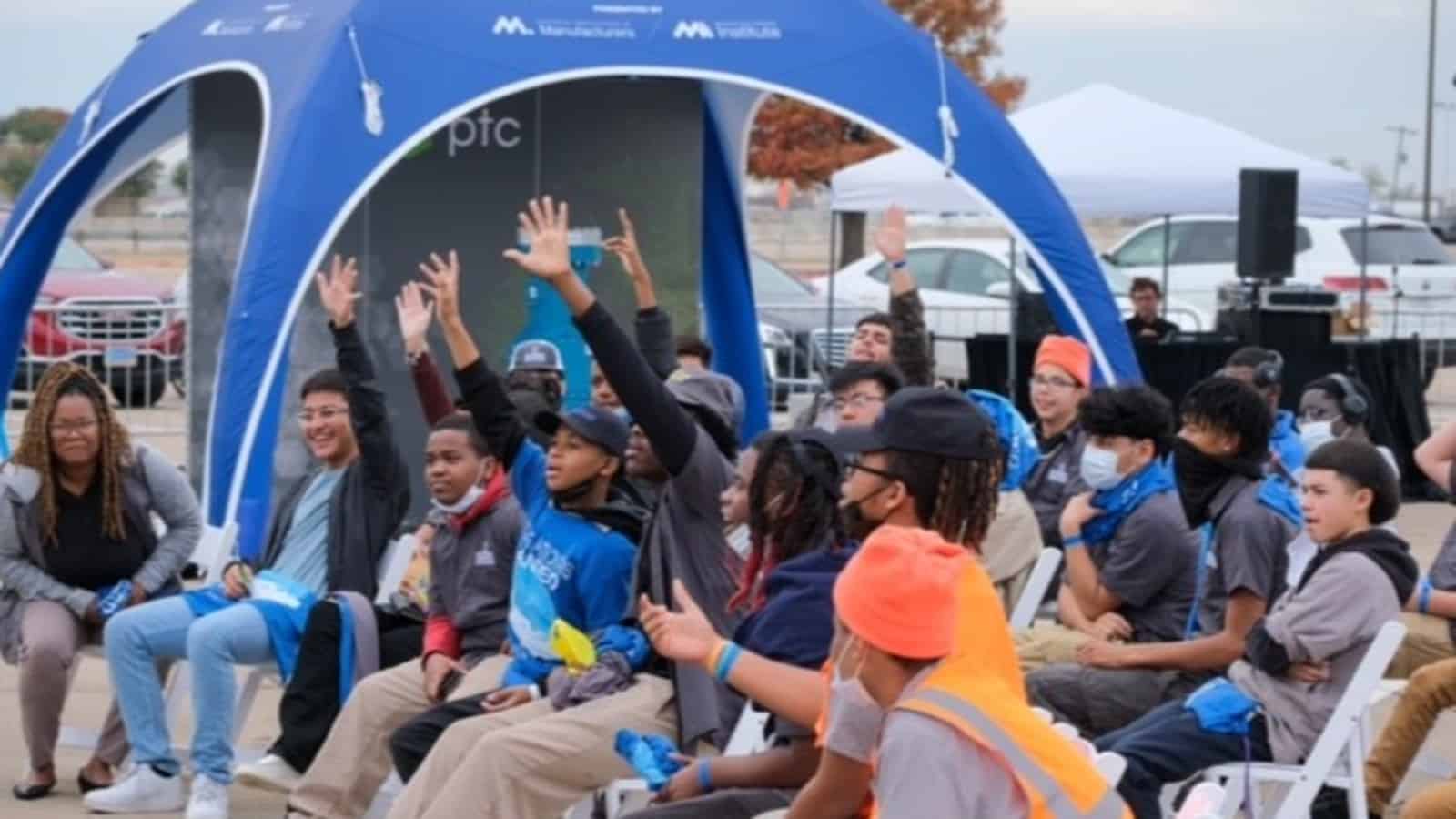
As the final 2021 stop on the Creators Wanted Tour Live circuit, Dallas/Fort Worth had quite a few expectations to live up to—and live up to them it did.
Big impact: With more than 1,000 students attending events, participating in panel talks and discussions and “racing to the future” in the Creators Wanted immersive experience, the Dallas/Fort Worth visit of the joint NAM/Manufacturing Institute project designed to inspire and educate the next generation of manufacturers had a very large audience—and a receptive one at that.
- “When we first mentioned it to them, they had never heard of Creators Wanted,” said Roberta Woodard, a high school professor at TCC South Collegiate High School in Fort Worth, of her students, who attended the Creators Wanted events. “But they were really excited about obtaining any information that they could to help prepare them for graduation.… These kids have [now] shown a great interest in hopping into the workforce as soon as they graduate.”
A truly hands-on experience: During the four-day tour stop, students, teachers and parents were able to try out numerous activities related to manufacturing, including using the VRTEX virtual reality arc welding training system and piloting drones at the Fort Worth Independent School District’s mobile STEM lab, exploring Vuforia augmented reality by PTC, interacting with displays by, and meeting creators at, Stanley Black & Decker, Cornerstone Building Brands, CRH and Nucor and completing the puzzles and escape-room challenges in the Creators Wanted mobile experience.
The chance to see and feel manufacturing firsthand was a game-changer for many attendees.
- “Sometimes it’s hard to teach students from a textbook, or even from online materials,” said Tuan Tran, professor of career and technical education at TCC South Collegiate High School. “And when they see real people here in front of them, talking to them, it gives them a little bit of a peek into what’s possible in the future.”
Family and money: One of the possibilities when it comes to manufacturing careers is the opportunity to make a very comfortable living, and to do so in an environment that values its employees, panelists told Creators Wanted attendees.
- “Now more than ever we need people in trades, we need people in the manufacturing industry, so manufacturing companies are starting to pay [what] you’re worth,” Oldcastle Infrastructure Plant Manager Brandon Castillo said during a Creators Wanted panel talk and Q&A session, echoing the findings of a recent joint MI–Deloitte study, which found that if the U.S. continues on its current trajectory, the U.S. will have more than 2 million unfilled manufacturing jobs by 2030.
“For me, it allows me the ability to take my kids to Disneyland or Disney World and just do a bunch of family activities that I’m not sure would be afforded to me if I didn’t choose manufacturing.”
- Added Blaire Basham, who is in human resources at Nucor Corporation’s Business Technology division: “We are a family first and a company second. Also, the biggest thing that we love is to make money, because who doesn’t? Money is our motivator.… Family and money, what can be better than that?”
Students had the opportunity to draw insights from not just the exhibitors, but also from Celanese, Specialty Packaging, Georgia-Pacific and the MI’s Heroes MAKE America initiative.
News nods: Texas and national media outlets, including the Fort Worth Business Press, NBC 5 Dallas/Fort Worth, KRLD Morning News 1080, The Dana Show and The Dan Bongino Show covered Creators Wanted Tour Live Dallas/Fort Worth.
Highlights from the stop: Here is a glance at some of the action:
Crowley High School students watch, mesmerized, as they see the laser engraver—and modern technology—help them unlock the next room of the immersive challenge. More than 74% of students who were skeptical about manufacturing left the experience either very or somewhat interested in learning more about manufacturing careers.
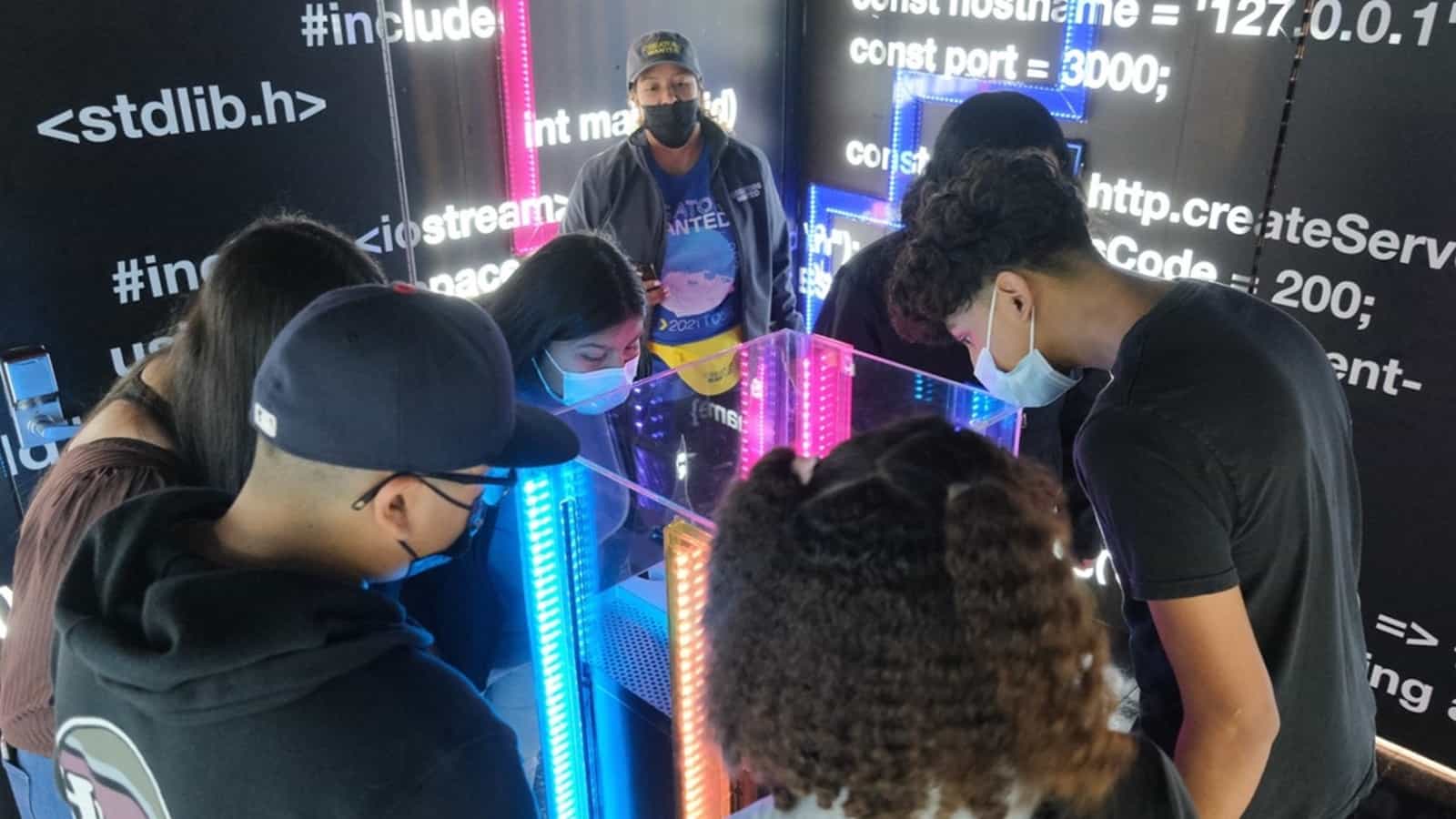
Students from Tarrant County College South hear about the career paths at Stanley Black & Decker.
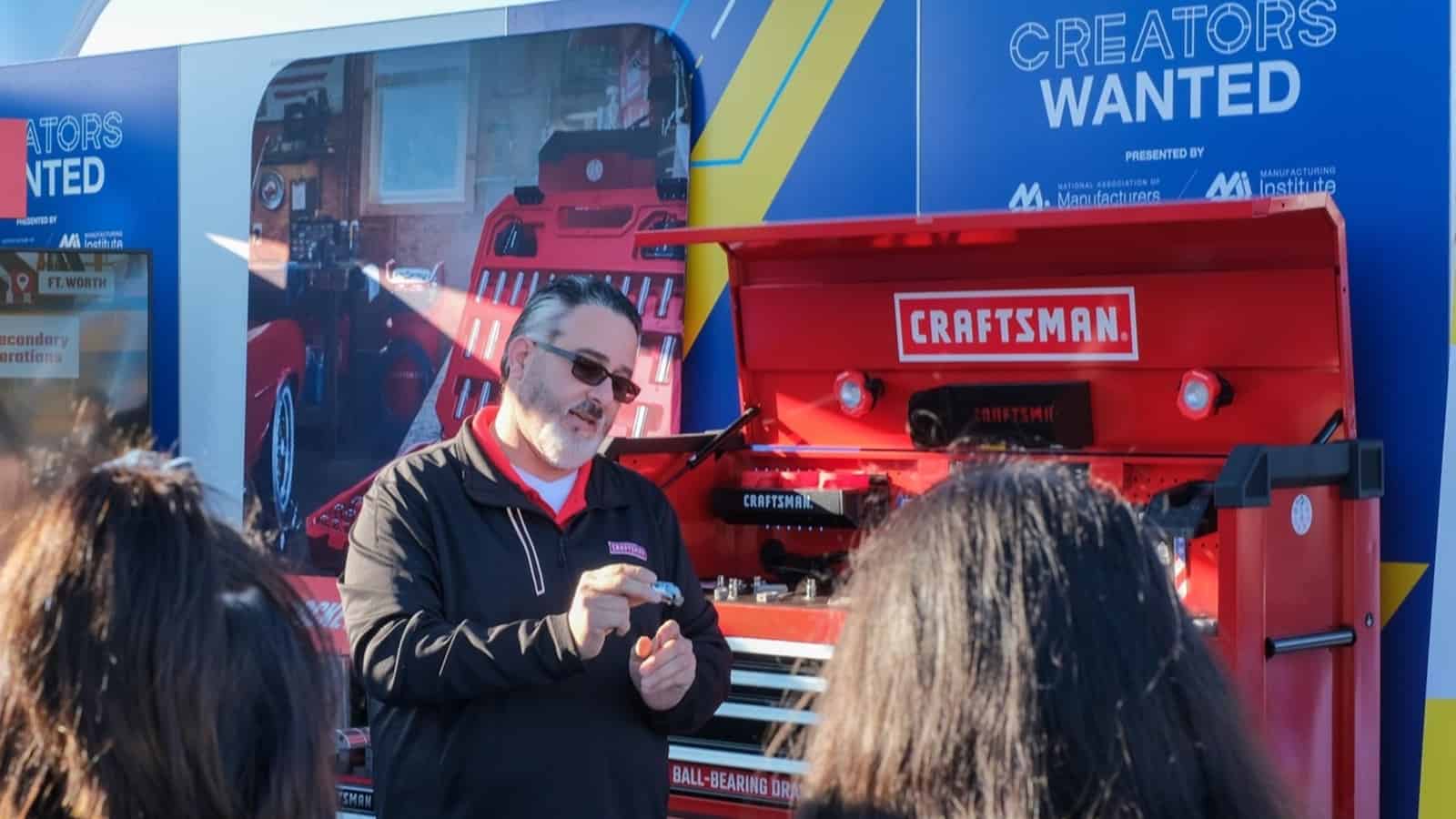
Students from Young Men’s Leadership Academy listen as Khristopher Kuker, plant manager, Dallas U.S. Windows Plant, Cornerstone Building Brands, lays out potential career paths at the company.
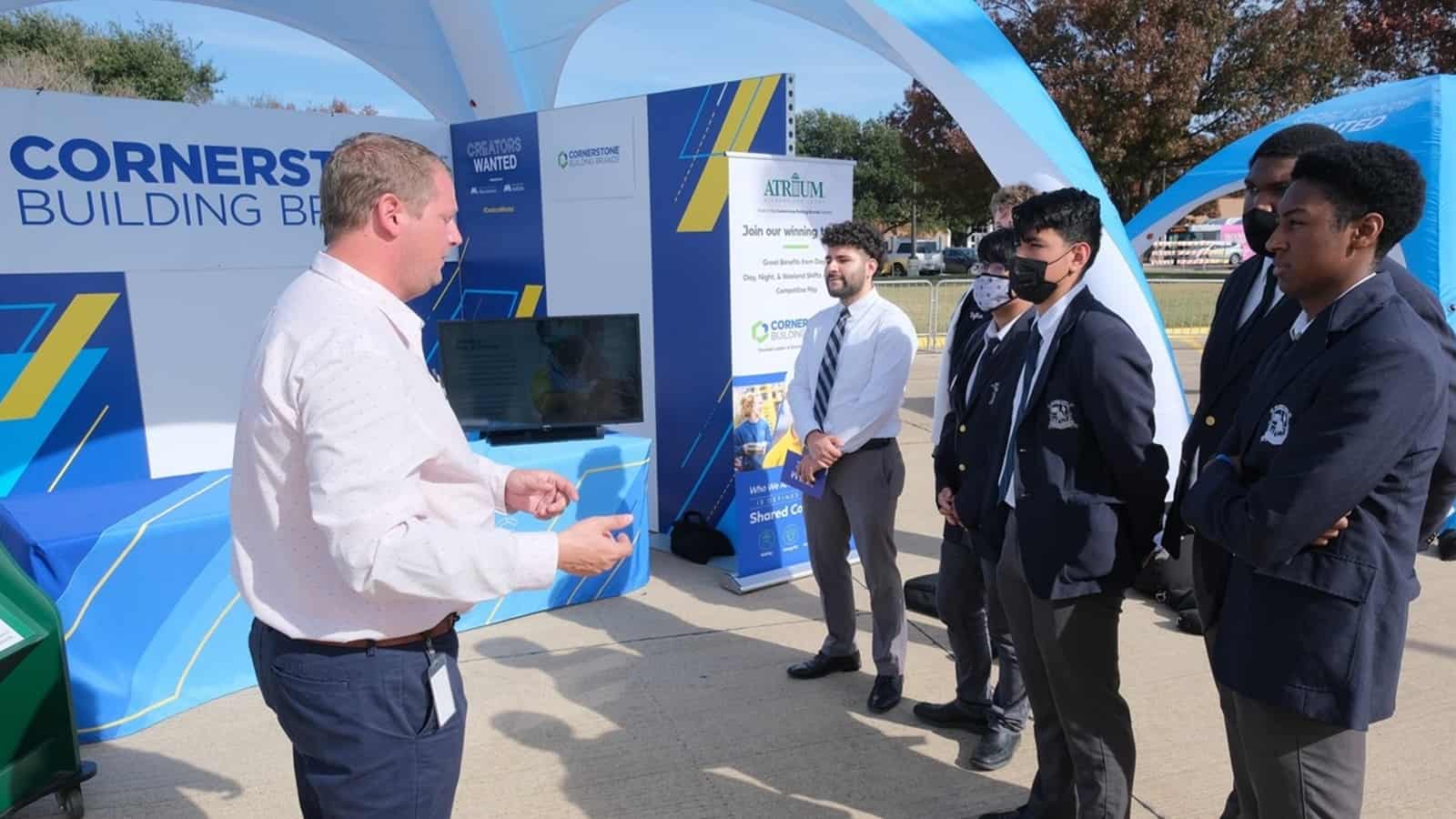
CRH brought crafts to the table, giving students a chance to connect one of its products, Sakrete concrete, with some of the attributes of manufacturing careers.
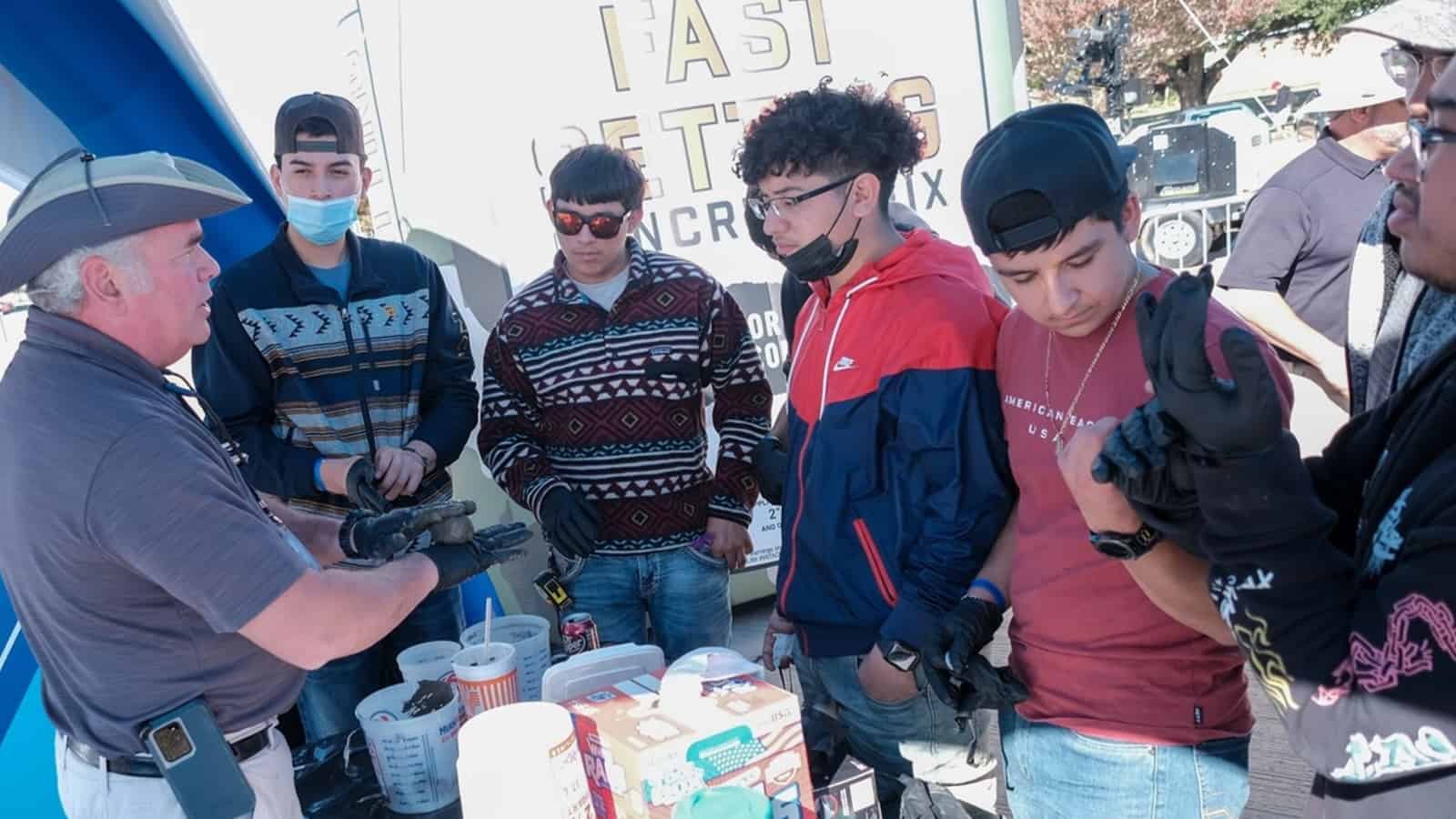
A student from North Crowley High School reacts to PTC’s augmented reality software.
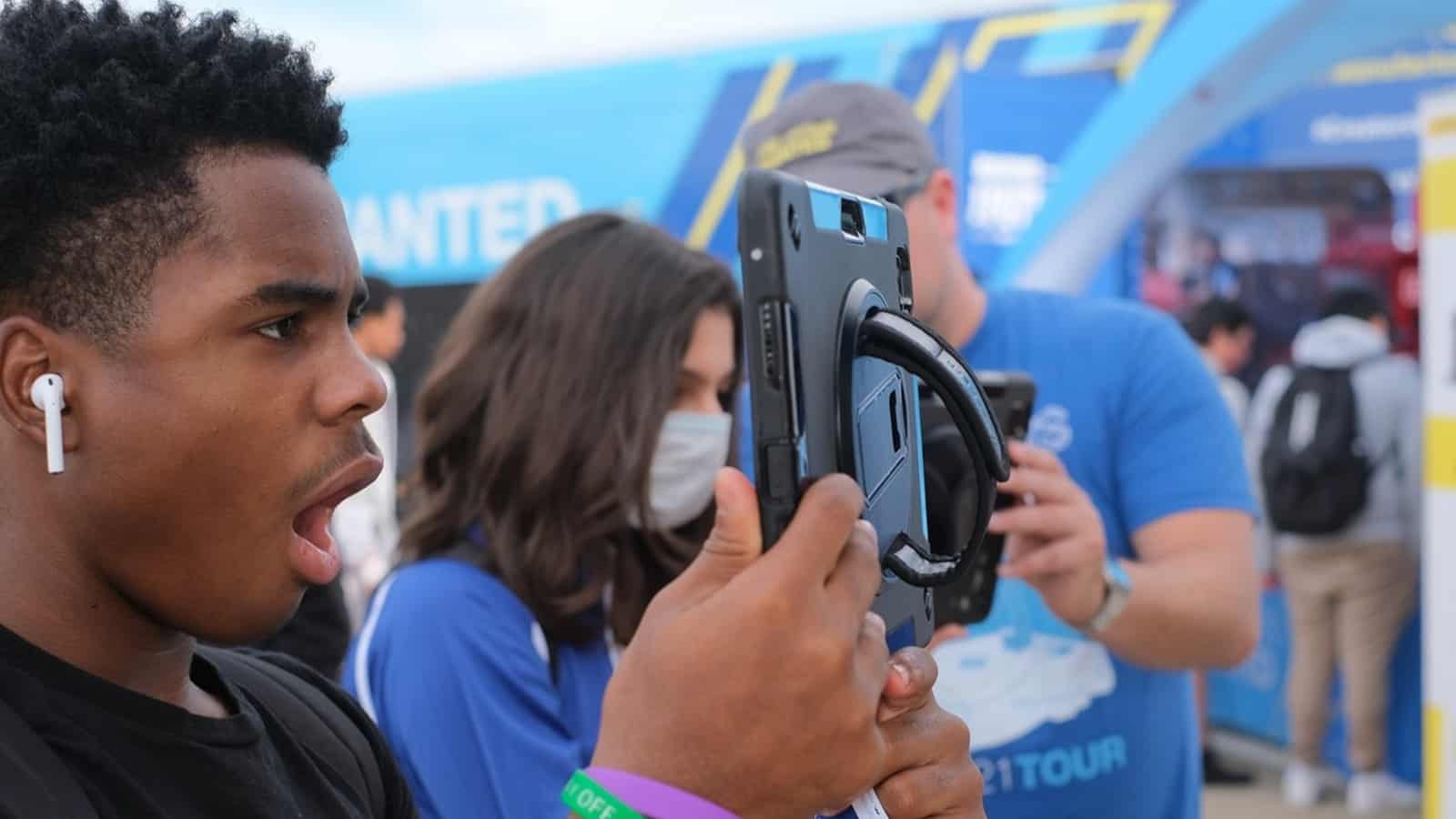
The race to the future had students working together to correctly identify the Honda vehicle from hints “left” inside the immersive experience from design, engineering and testing Honda associates.
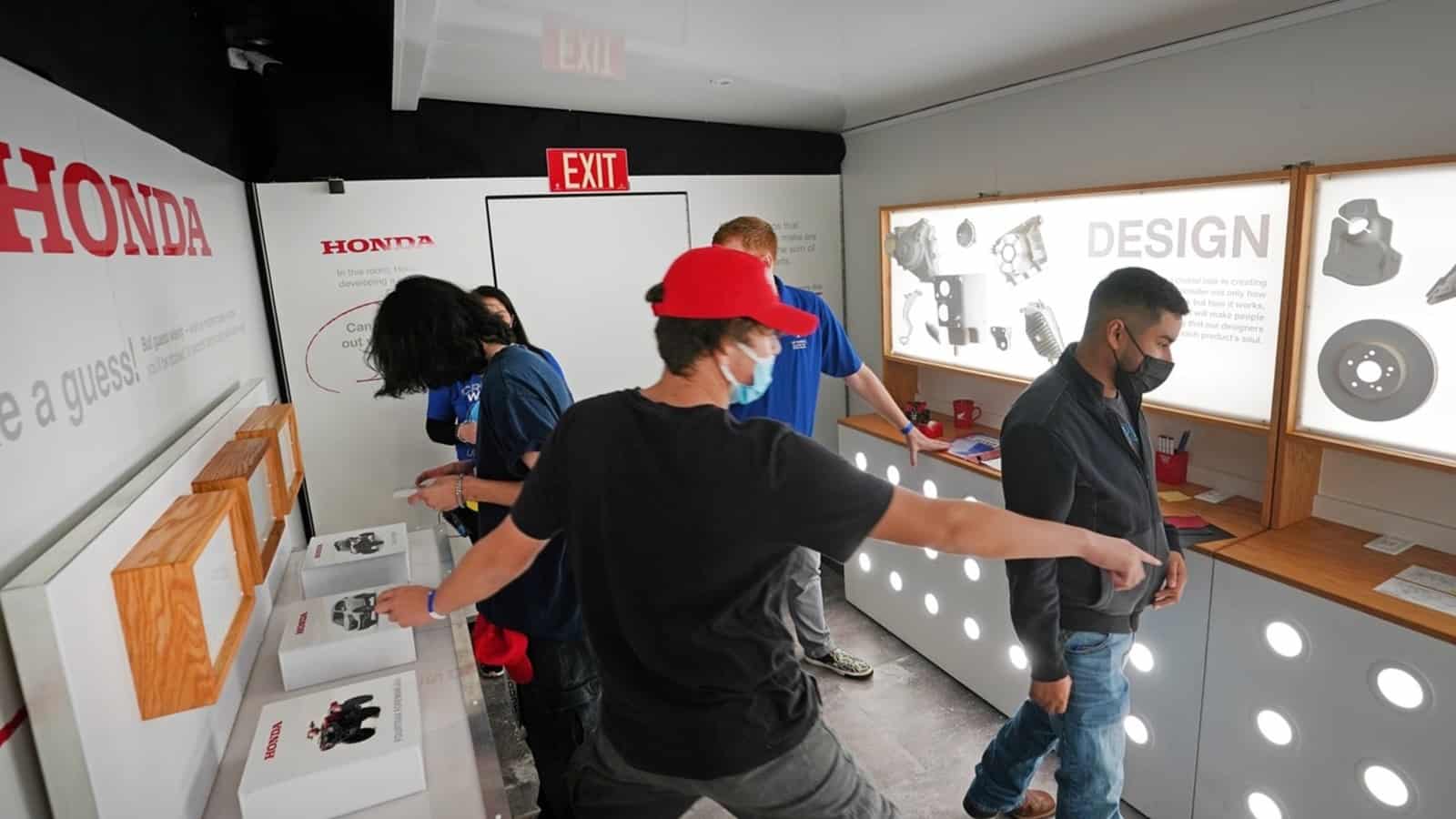
On stage, Specialty Packaging President Hank Dorris and his mentee, Brian Wade, emphasize the importance of mentorship to students at Jacquet Middle School. Dorris, whose company makes products for companies such as Dunkin’ Donuts, Sonic, Chili’s and Wrigley, was personally instrumental in bringing the tour to Fort Worth, marshalling major school districts and key partners to engage as many students as possible.
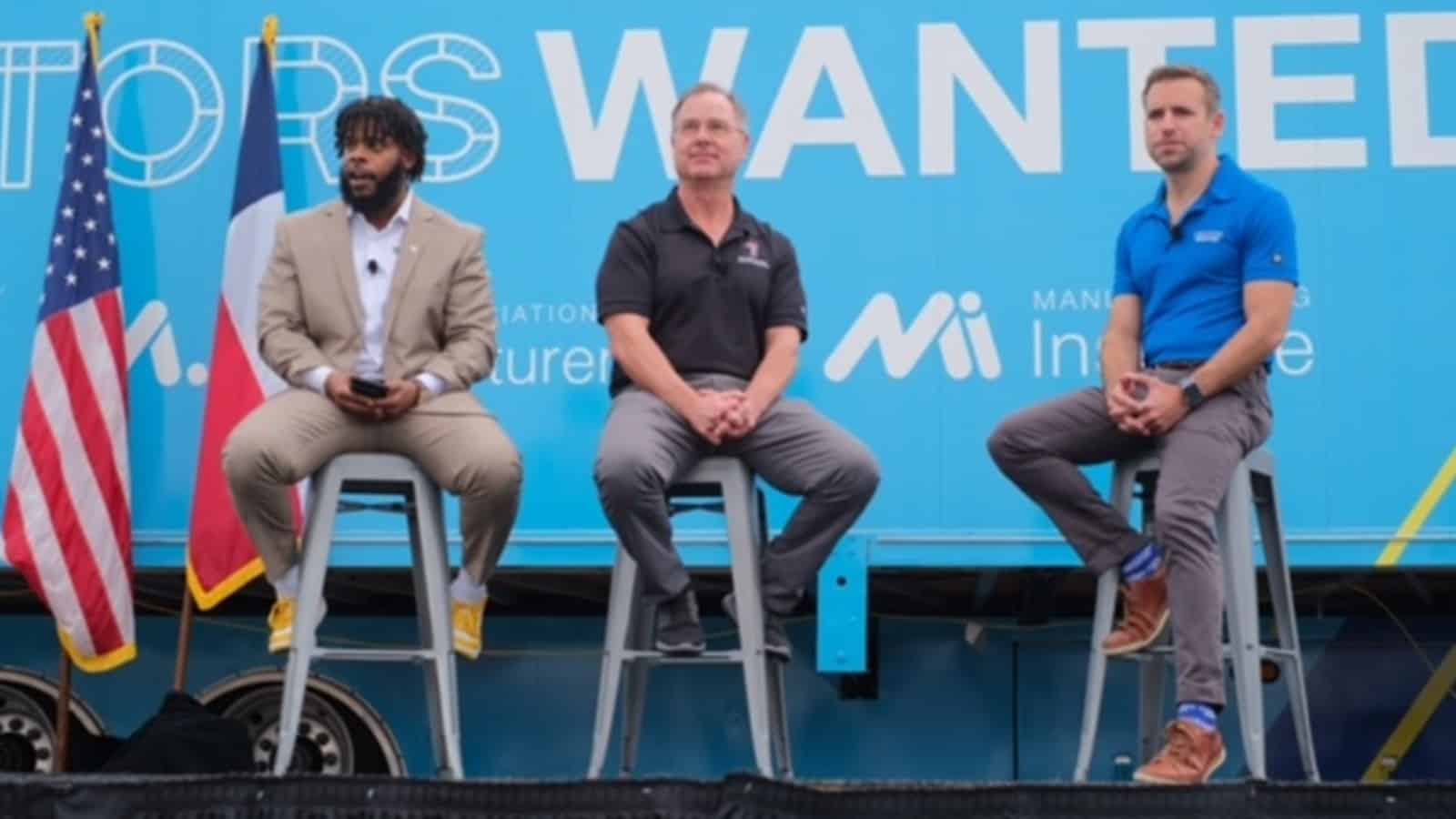
The social media response: School participants, including Tarrant County College and Kennedale Career & Technical Education, tweeted photos of their students learning about manufacturing careers—and having a blast doing it.
TCC has been proud to partner with @FortWorthISD, the @ShopFloorNAM and @TheMfgInstitute to host the Creators Wanted Live Tour. Students have had the chance to interact with manufacturers in entertaining ways during this innovative experience. Learn more: https://t.co/lZBSNd51HD pic.twitter.com/kFDY8Ewfq2
— TarrantCountyCollege (@TCCollege) December 2, 2021
A group of KHS students were able to go and check out #CreatorsWanted today and learn about careers in manufacturing!! #CTE @urkhsprincipal pic.twitter.com/nh7uBCJPMd
— Kennedale Career & Technical Education (@KennedaleCTE) December 3, 2021
The tally: In addition to more than 1,000 students who joined the tour, the tour stop helped Creators Wanted move beyond 153,000 email signups from students and other individuals interested in manufacturing careers and exceed 138 million digital impressions.
The last word: The Creators Wanted Tour Live had such a positive reception it was invited for an encore. Said Woodard: “You guys rock. Come back and see us.”
A Union Pacific Executive Gets Career on Track
Get the Latest News
Get involved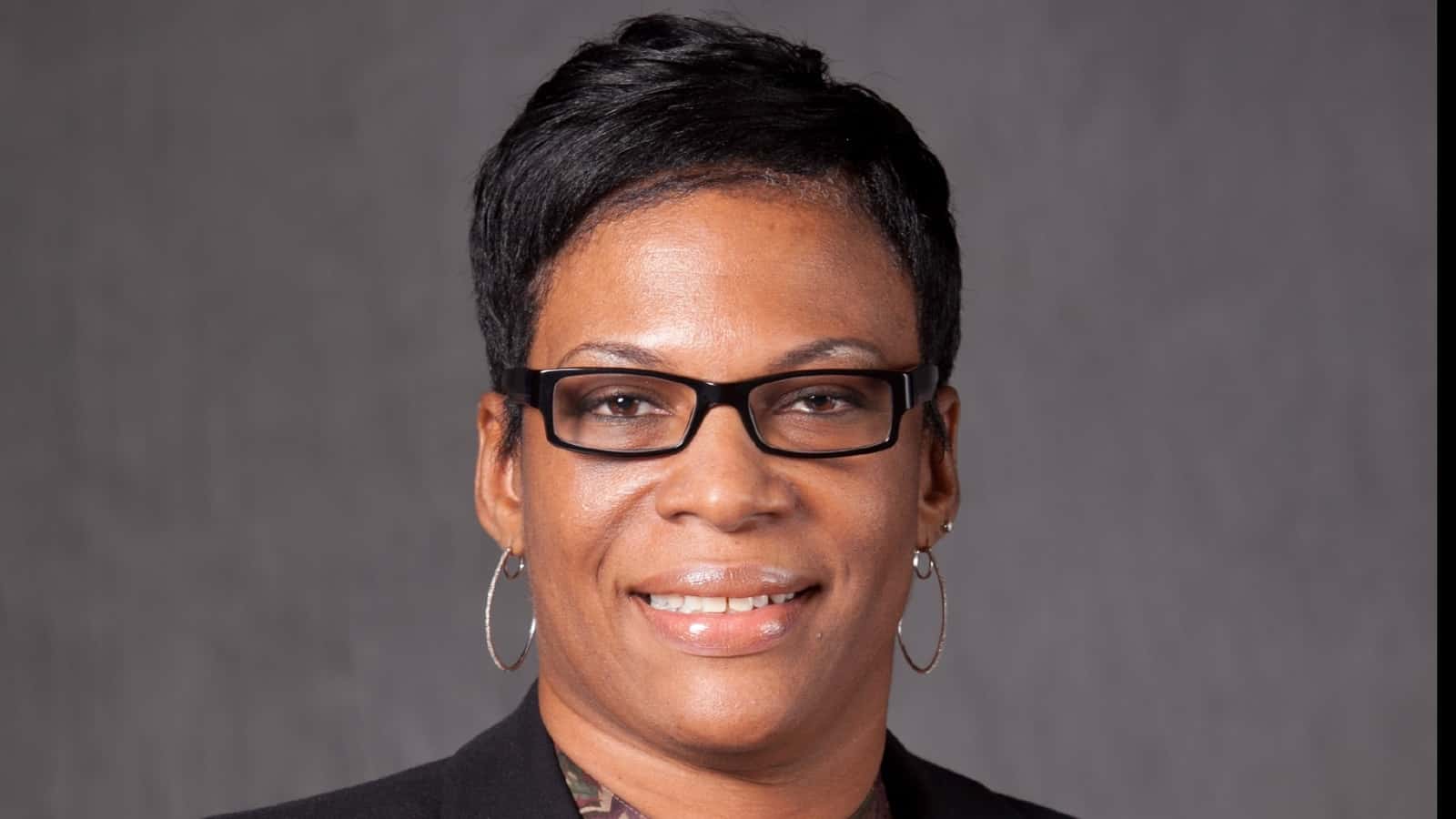
Benita Gibson didn’t set out to join the rail industry, but after 15 years at Union Pacific Railroad and 30 years in management across three different industries, she serves as Union Pacific’s general superintendent for commuter operations in Chicago—and she wouldn’t have it any other way.
A big job: Gibson oversees Union Pacific’s North, Northwest and West Metra Lines. Before the COVID-19 pandemic began, the route carried 194 trains and 100,000 passengers every weekday. While the pandemic has disrupted some passenger rail travel, Gibson continued her focus on making the system work flawlessly, supervising everyone from engineers and conductors, to locomotive and car shops, to ticket agents and Maintenance of Way employees to ensure safe and efficient operations.
A pioneering leader: Gibson is the first Black female operating executive in Union Pacific’s history, but she hopes that the doors she opened will encourage more women and, specifically, more women of color to join her.
- “When I started, you really had to stand your ground and let people know you were part of the team,” said Gibson. “I really just want to be treated equally. My main focus was, I wanted to be able to do what was expected of anyone to do, not just a male or female.”
Opportunity for all: Gibson encourages other women to look for roles in the transportation sector, emphasizing the breadth of opportunities that are available for people interested in being a part of a large and growing industry.
- “We have everything within this company,” said Gibson. “We have marketing and sales, real estate and law, accounting and logistics. People don’t realize all the opportunities there are within a railroad. Every job and career type that’s out there is right here at Union Pacific.”
Now hiring: Union Pacific is also interested in promoting opportunities for women who might not have thought about a career in rail previously—and they’ve got big plans to do it. Through a $3 million, three-year partnership with The Manufacturing Institute—the NAM’s workforce development and education partner—Union Pacific intends to double the number of women in its workforce within the next 10 years. The initiative that works in tandem with Creators Wanted is called Careers on Track and is designed to inspire more women and youth to pursue modern industry careers through workforce development and career solutions. It includes:
- A digital STEM curriculum;
- A virtual STEM experience allowing participants to explore interactive 3D models of facilities and locomotives;
- A STEM micro-grant program for young people; and
- A digital campaign that demystifies career opportunities for underserved women.
The last word: “Being a young female getting into this career is exciting,” said Gibson. “It offers great pay, great camaraderie and the chance to learn a lot. You have an opportunity to see a lot of different places within the 23 states where we operate. Our motto is ‘Building America,’ and that’s exactly what you get to do.”
“You’ll Never Be Bored”: Exciting Careers on Display in Dallas/Fort Worth
Get the Latest News
Get involved
What was the collective mood at the premier event of Creators Wanted Tour Live’s fifth stop? Upbeat and excited. In Dallas/Fort Worth Tuesday, before racing to the future in the Creators Wanted mobile experience, students from Tarrant County College and local high schools heard from leaders in education and manufacturing about the industry’s many exciting career opportunities.
Upward mobility: “You’ll never be bored working in manufacturing, I can assure you that,” said NAM Senior Vice President of Communications and Brand Strategy Erin Streeter. “A career in manufacturing will grow with you over time, so you may start as a welder and end up as a CEO.”
- Indeed, there is no shortage of manufacturing jobs; only a shortage of people to fill them, Tarrant County College Chancellor Eugene Giovannini said at the kickoff. “Why is this happening now?” he asked, referring to the Creators Wanted tour, a joint project of the NAM and The Manufacturing Institute. “Millions of jobs [are] going unfilled because of not having people skilled to do [manufacturing] jobs.”
- In fact, the U.S. will need 4 million manufacturing positions over the next decade, Giovannini said, referencing a figure from a joint MI–Deloitte study. “It’s folks like Creators Wanted … that make you prepared” for those jobs.
Opportunity abounds: “The students here in front of me … are graduating here in North Texas at an ideal time,” said Fort Worth Independent School District Superintendent Dr. Kent Paredes Scribner, who presides over a school district of more than 70,000 students. He also said that the demand for technical and certification programs at Fort Worth schools has increased significantly each year in recent years. Scribner indicated that more than 1,000 students would join Creators Wanted in Fort Worth.
- Aicha Davis of the Texas State Board of Education echoed this sentiment. “One of our most important duties is to make sure that you have what you need to be successful when you graduate,” she told the audience at the kickoff. “And we listen to different industries … one of the number-one demands is for manufacturing … because we have so many different items that we ship in and out of Texas.”
A re-envisioned future: Manufacturing gives those who work in the sector the chance to discover themselves and their callings, the speakers at the premier event told the many students, teachers and parents in attendance.
- Jessie Kessler, site leader of the Northlake Distribution Center Site for Stanley Black & Decker, a Creators Wanted Innovator sponsor, told the audience she started at SB&D 22 years ago “answering phones … as a temp” and never dreamed it would lead to a career with the company. “The [number] of opportunities that are in the manufacturing sector opened up the world to me. … There’s definitely opportunity to grow and to learn and to move up. You’re not stuck at one job forever when you step into a manufacturing facility.”
- Cornerstone Building Brands Supply Chain Senior Vice President Brigette Gage, who spoke at the event, told the crowd that her career goals have come a long way since she got her start in the workforce. “I started as an engineer; I wanted to design roller coasters,” Gage said with a laugh. “But I found out that … actually making something was certainly a lot more fun” than designing it, “and it’s where I found my niche in my career. … At Cornerstone, we absolutely recognize the importance of making sure we’re continually evolving.” Cornerstone Building Brands is a Leader sponsor of the tour.
Responding to the call: Before tours of the Creators Wanted mobile experience and its popular escape-room challenges, MI Executive Director Carolyn Lee wrapped up the kickoff event by reiterating the need for skilled people in manufacturing.
- There are 900,000 open jobs in manufacturing today, Lee said. By 2030, that number could grow to 2.1 million, and those unfilled jobs “will harm our communities. … You can be part of that next wave of creators. Regardless of your interest, there’s a place for you.”
For quick video highlights of the premier event, click here.
